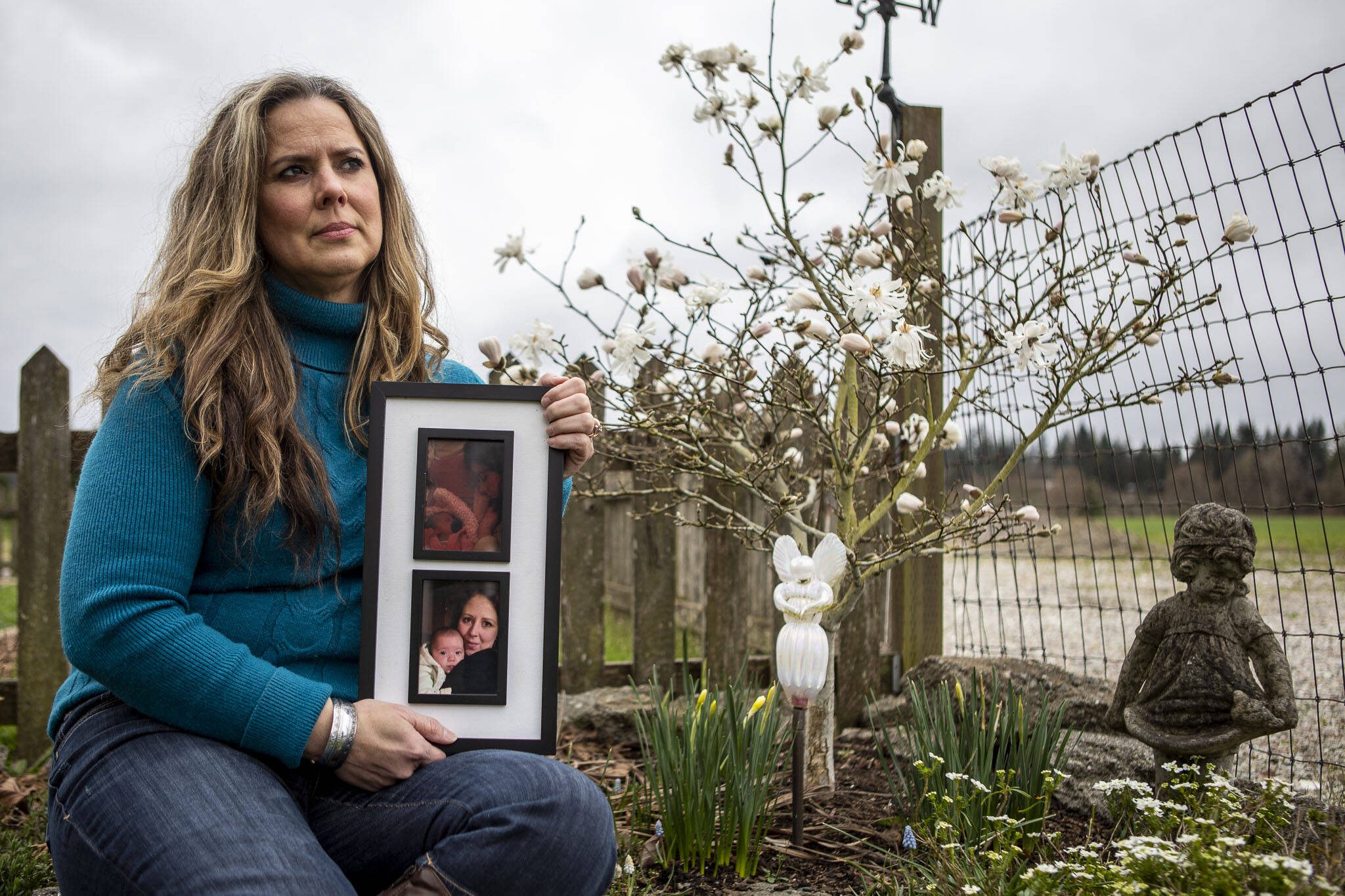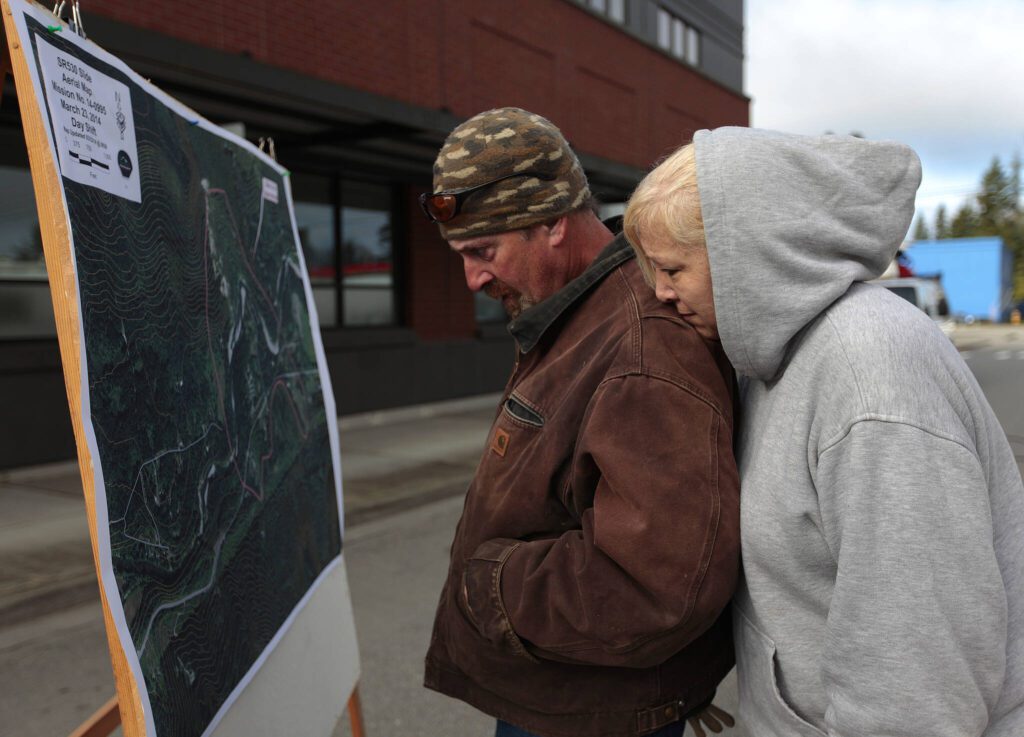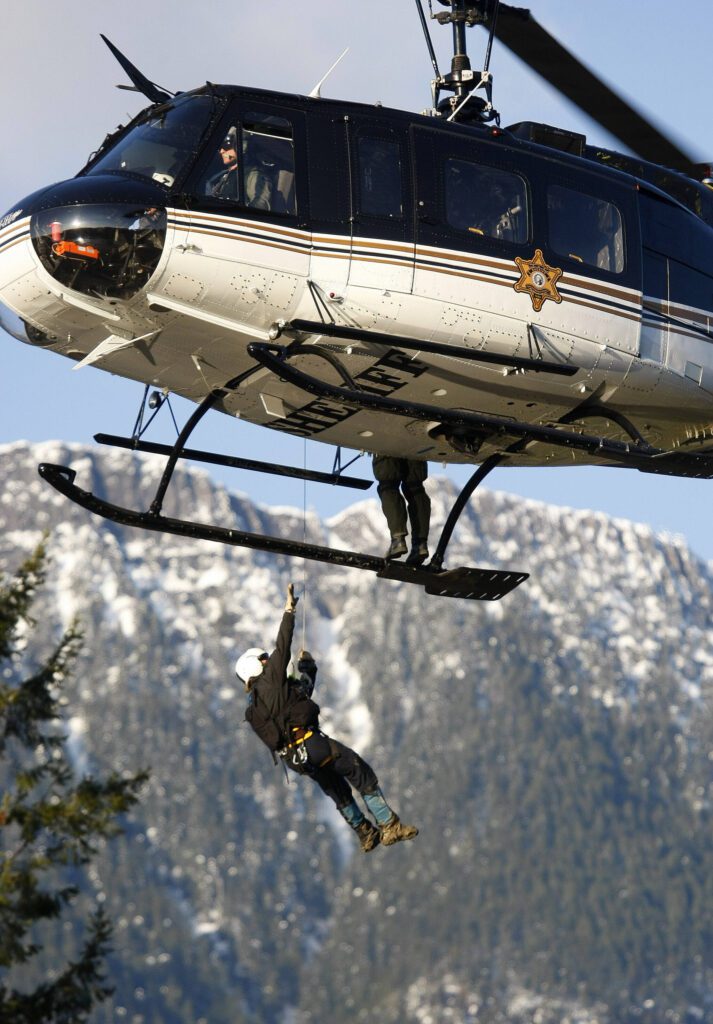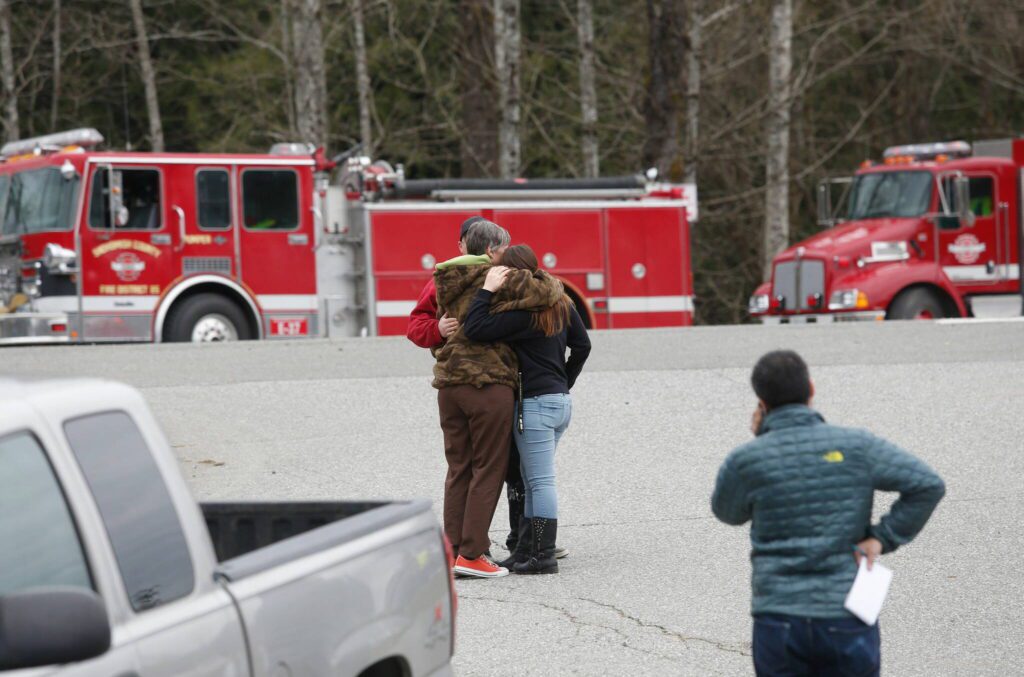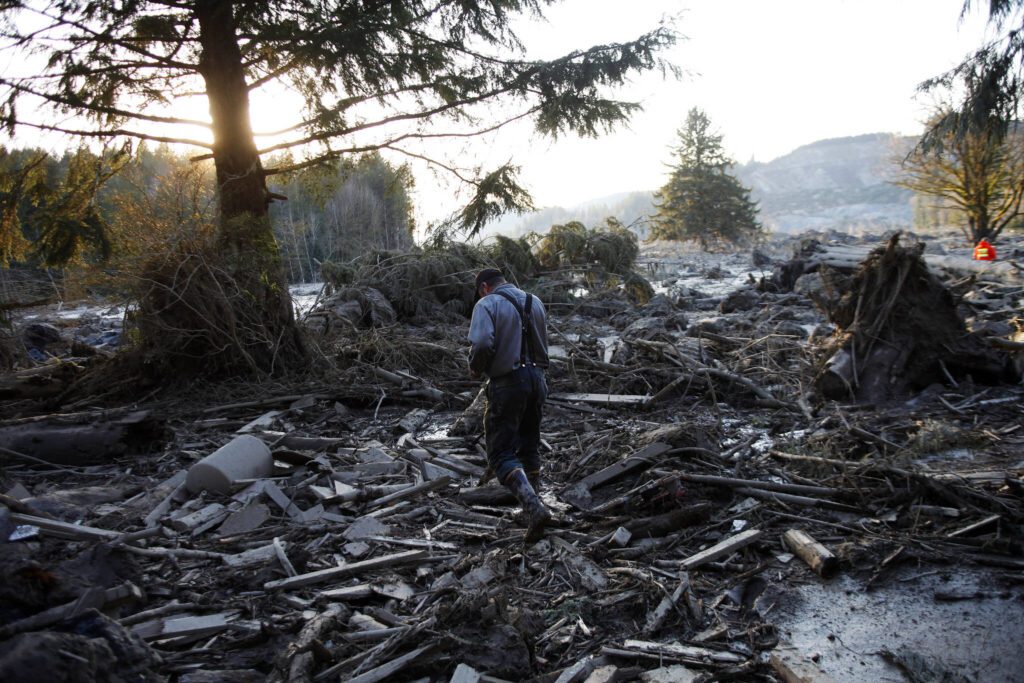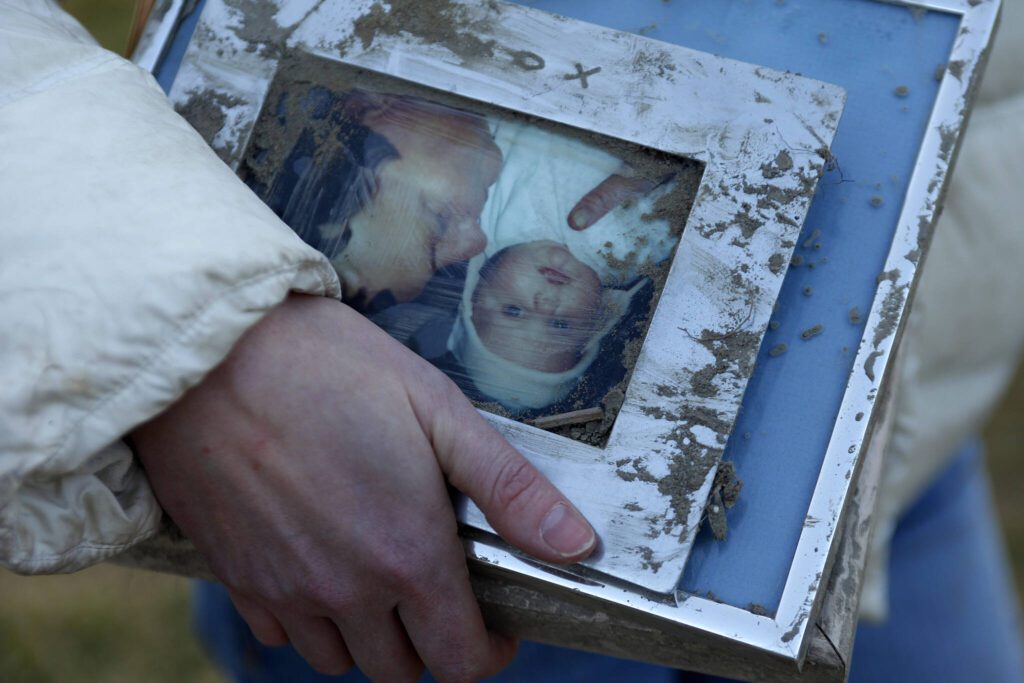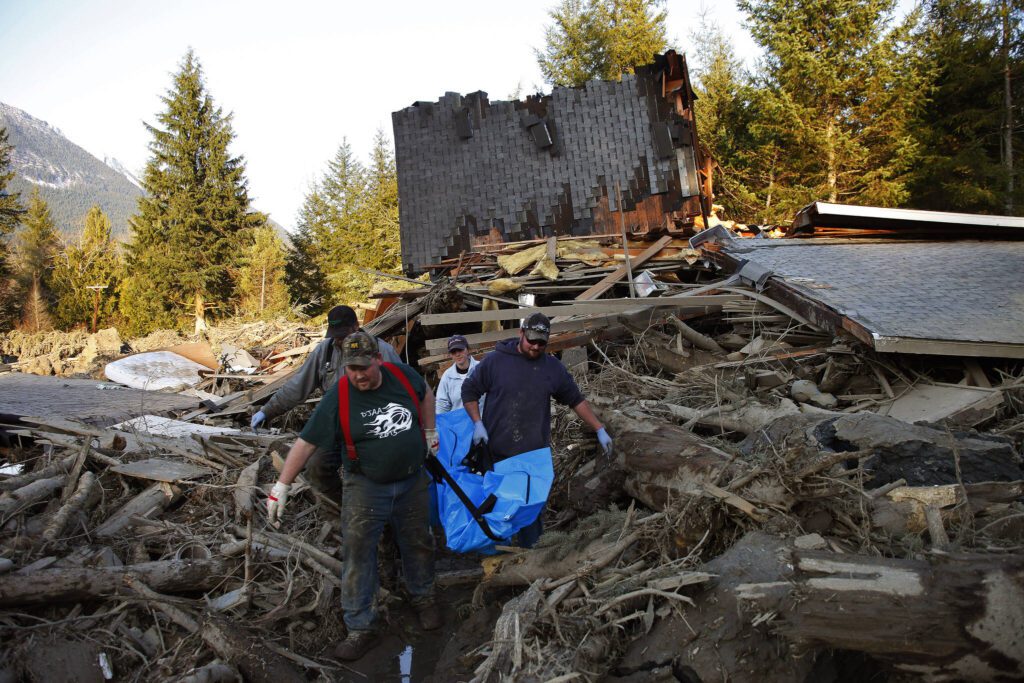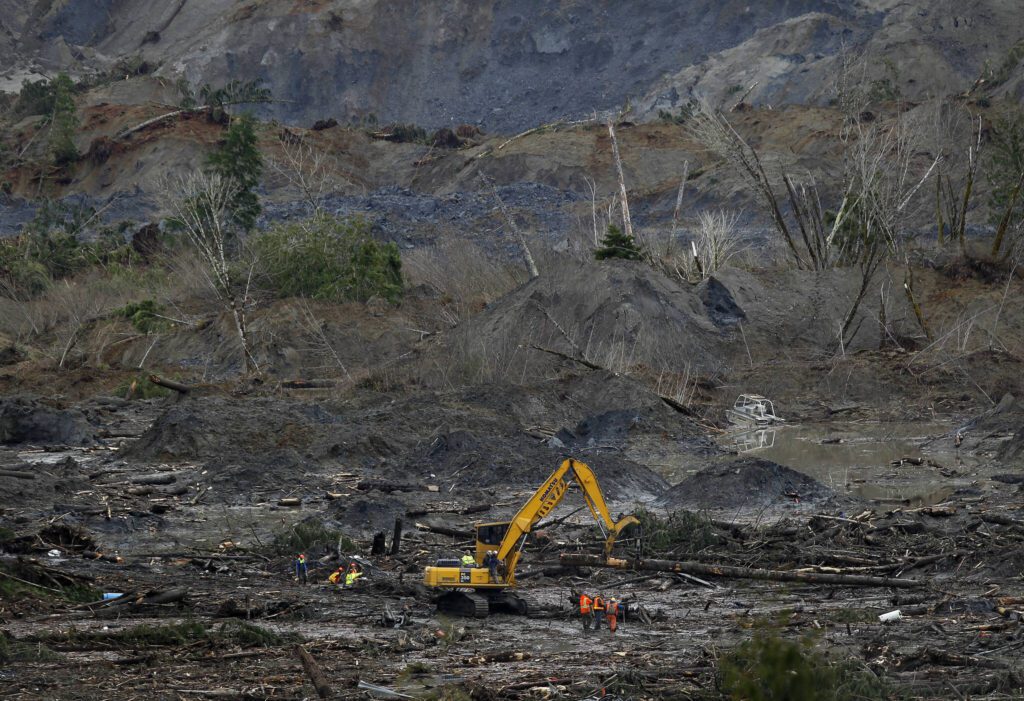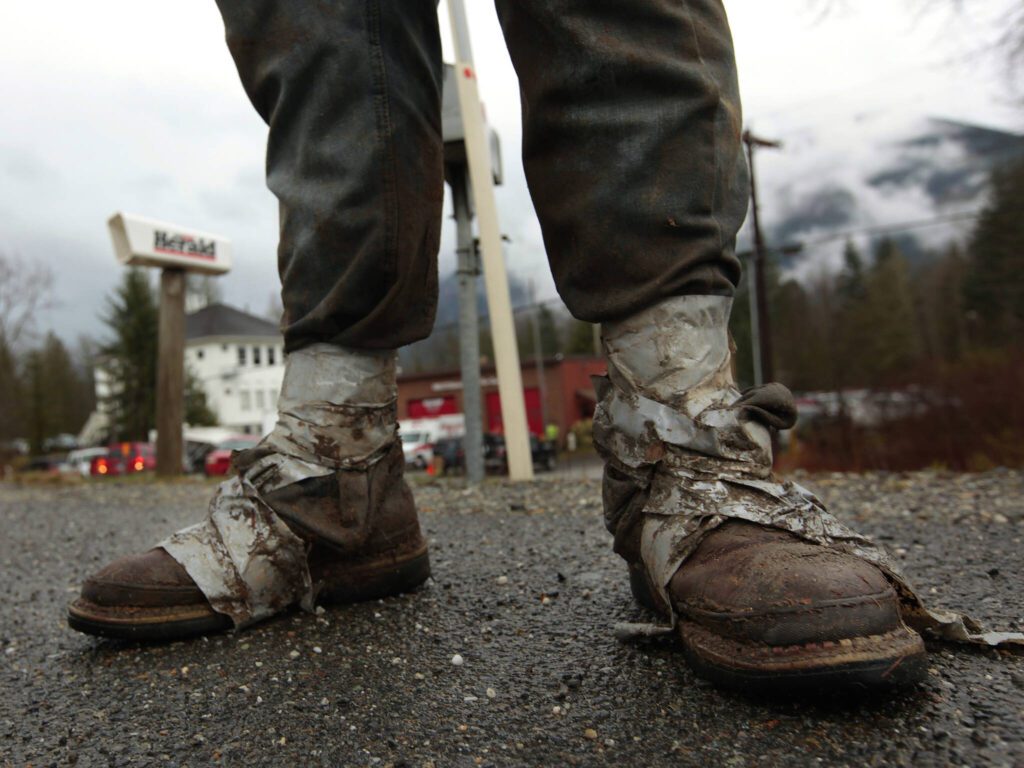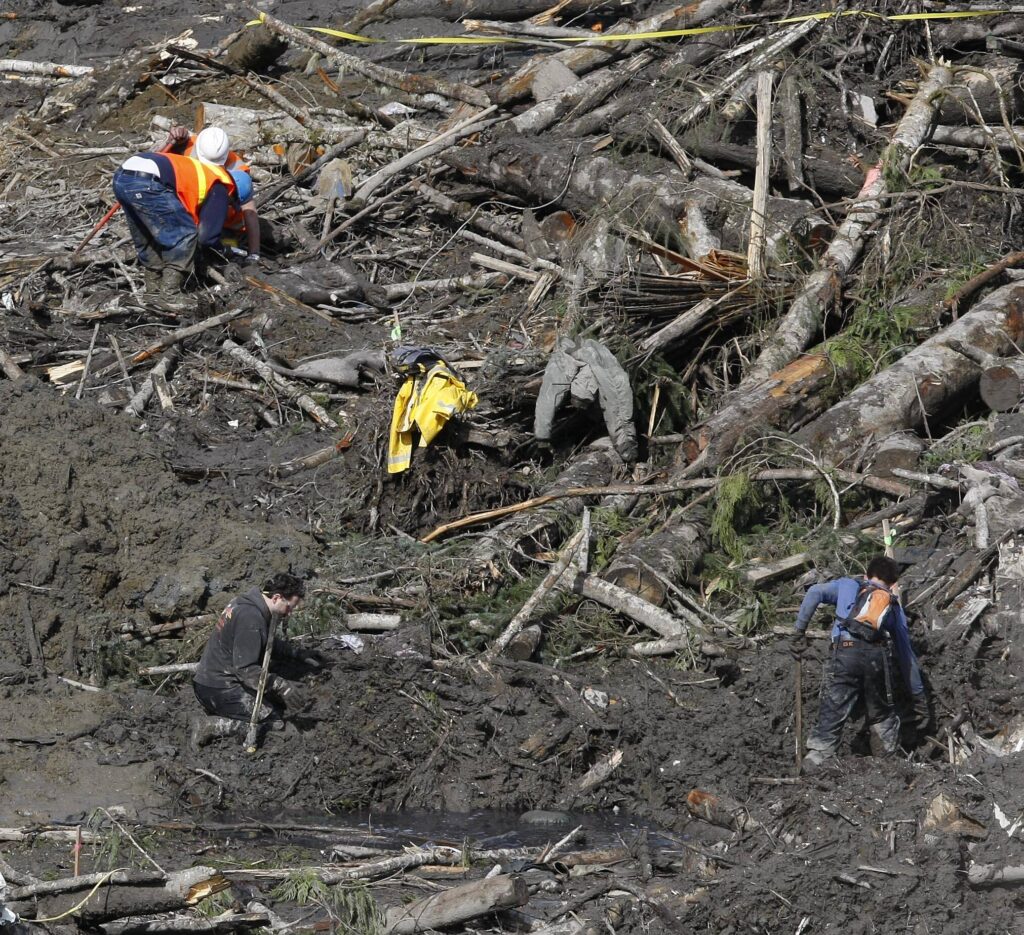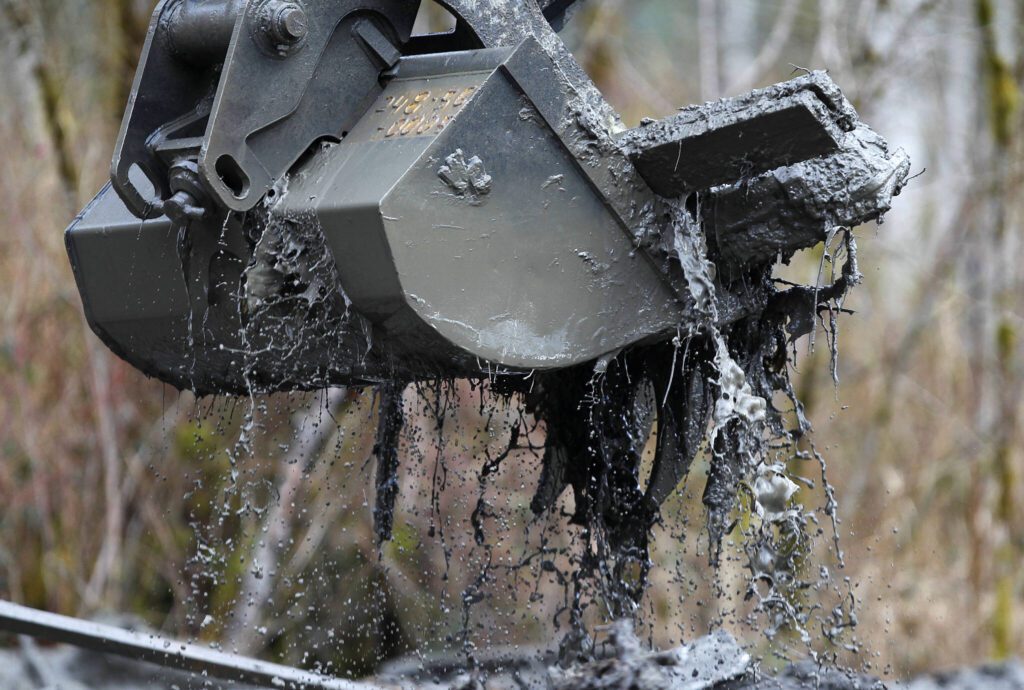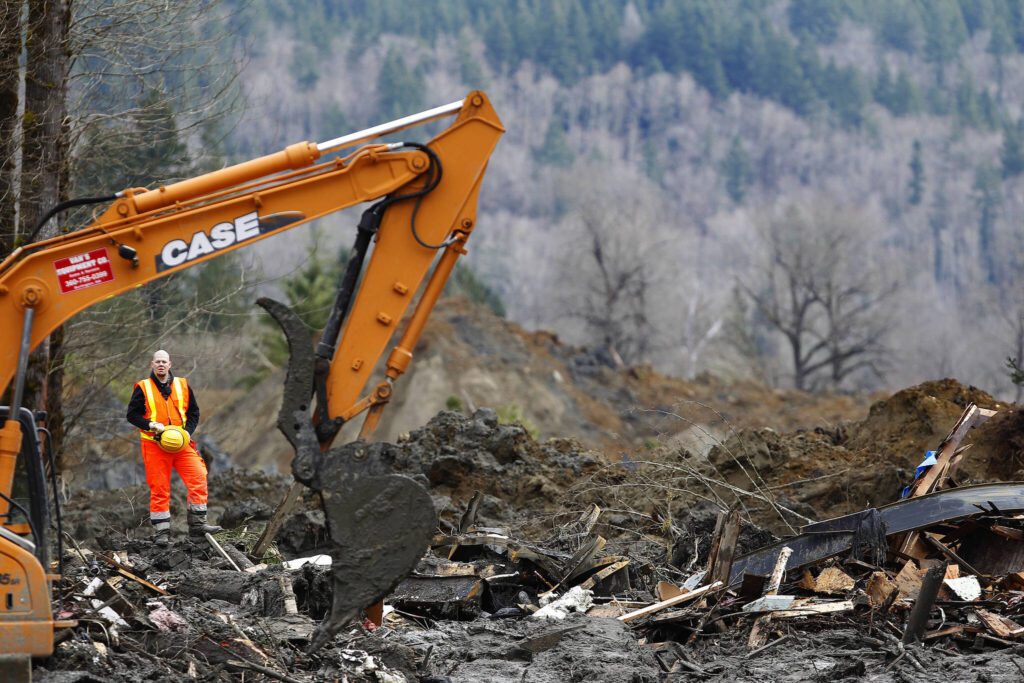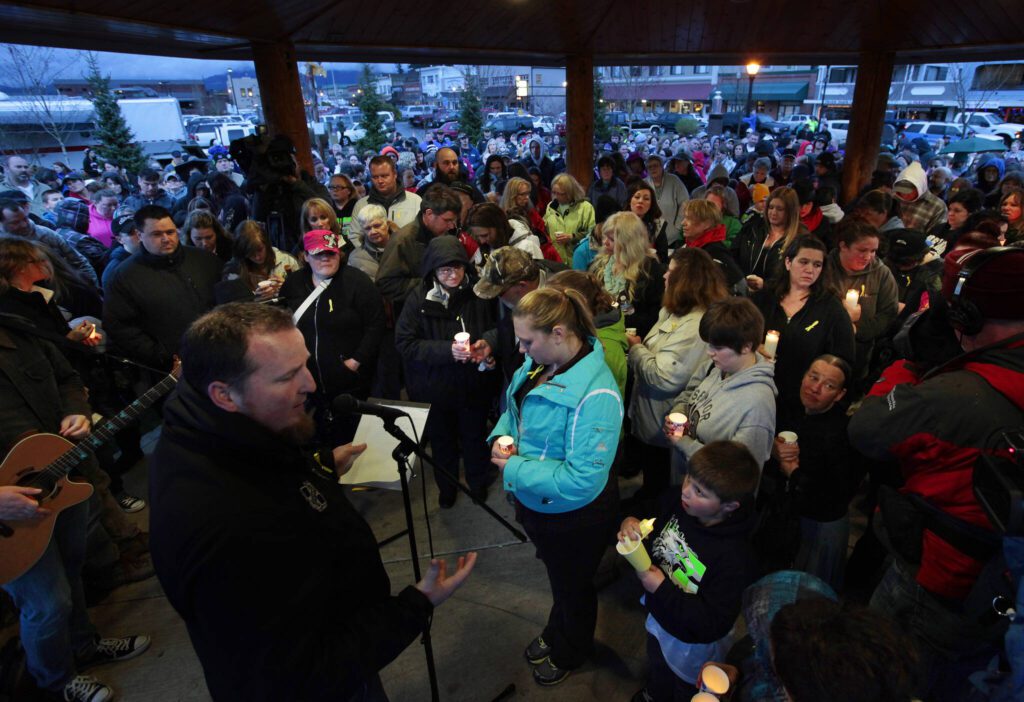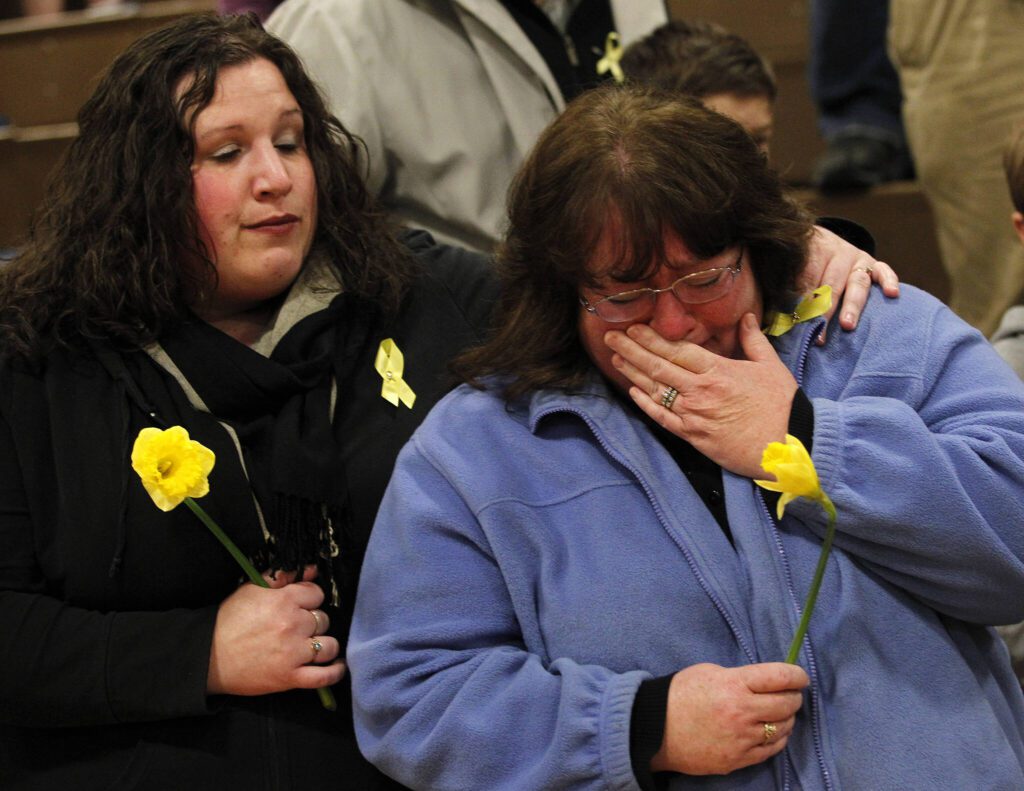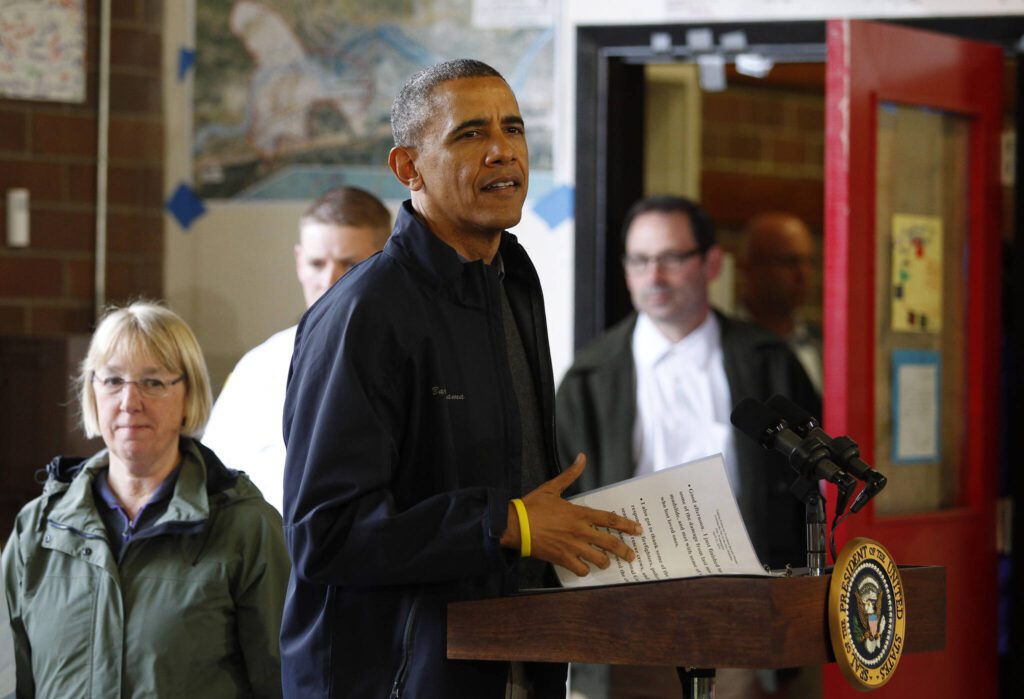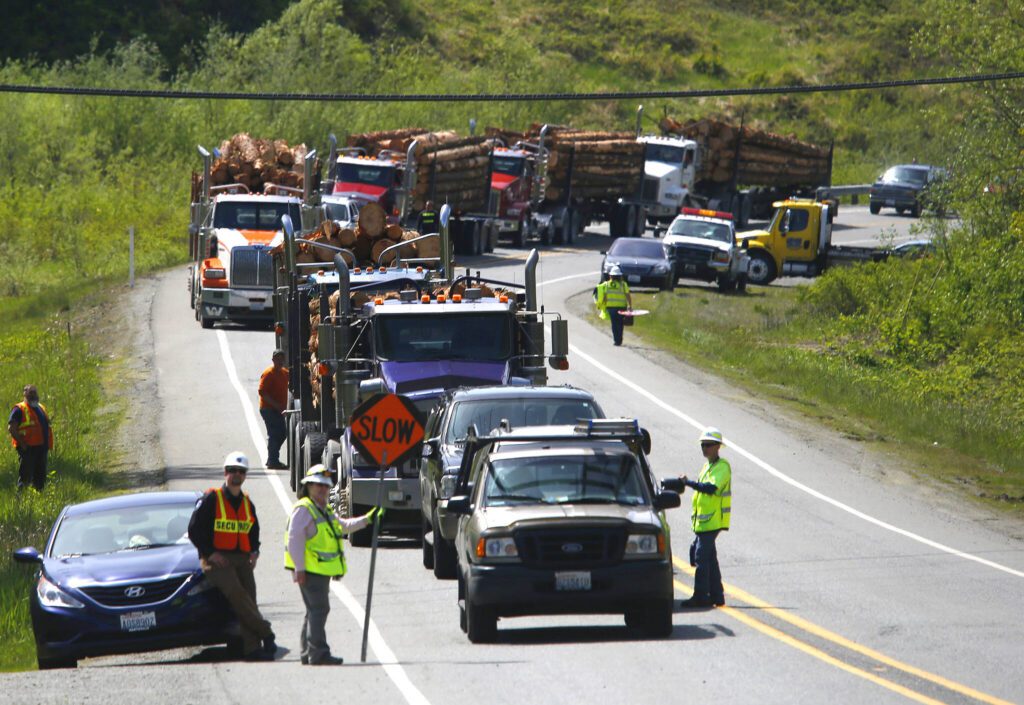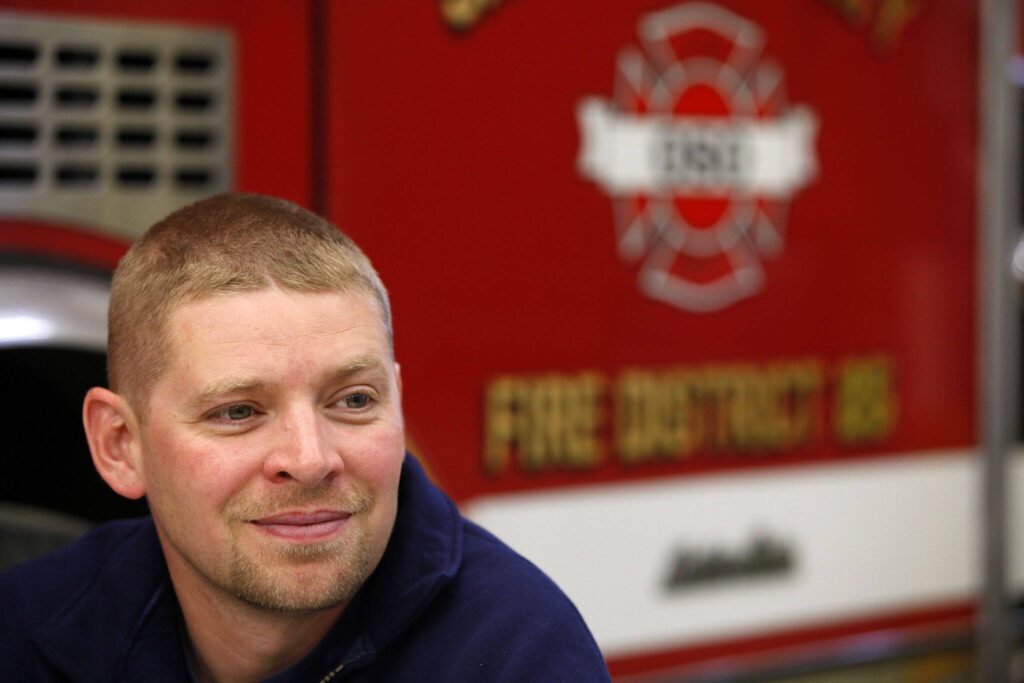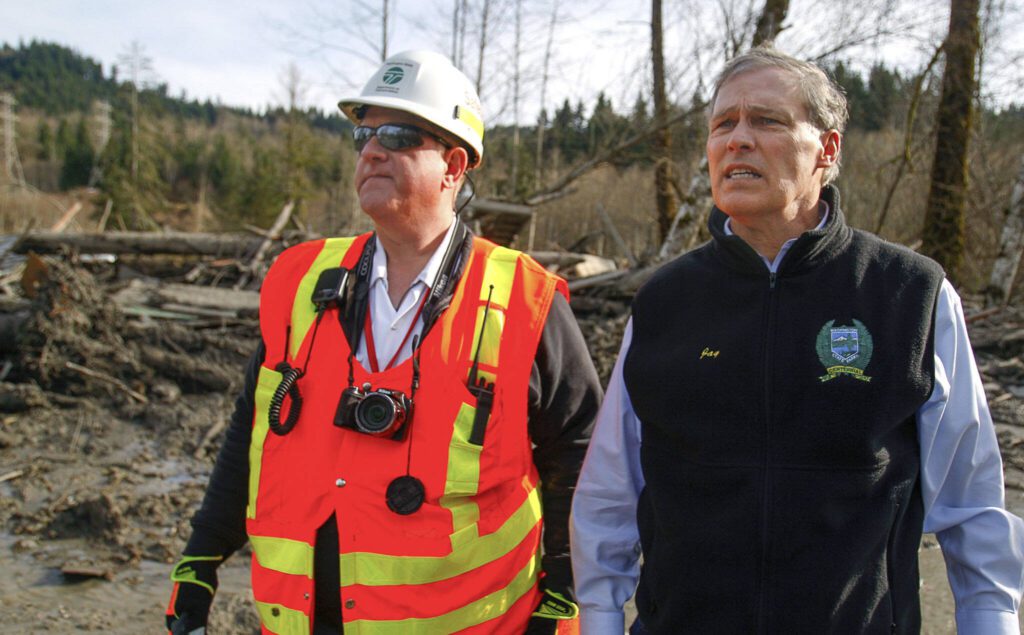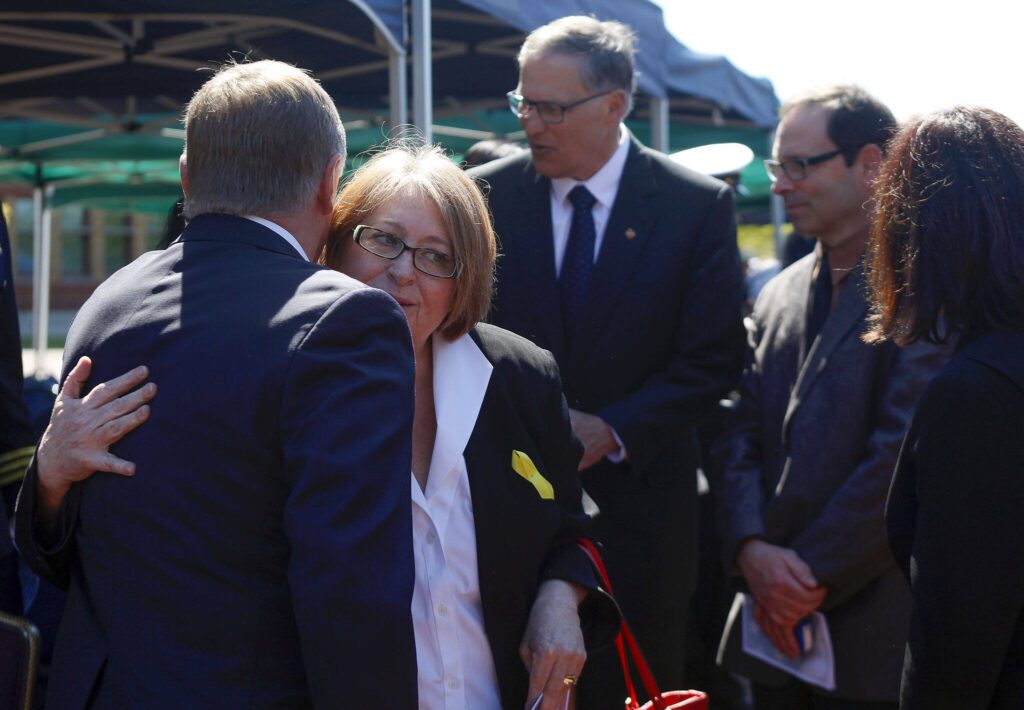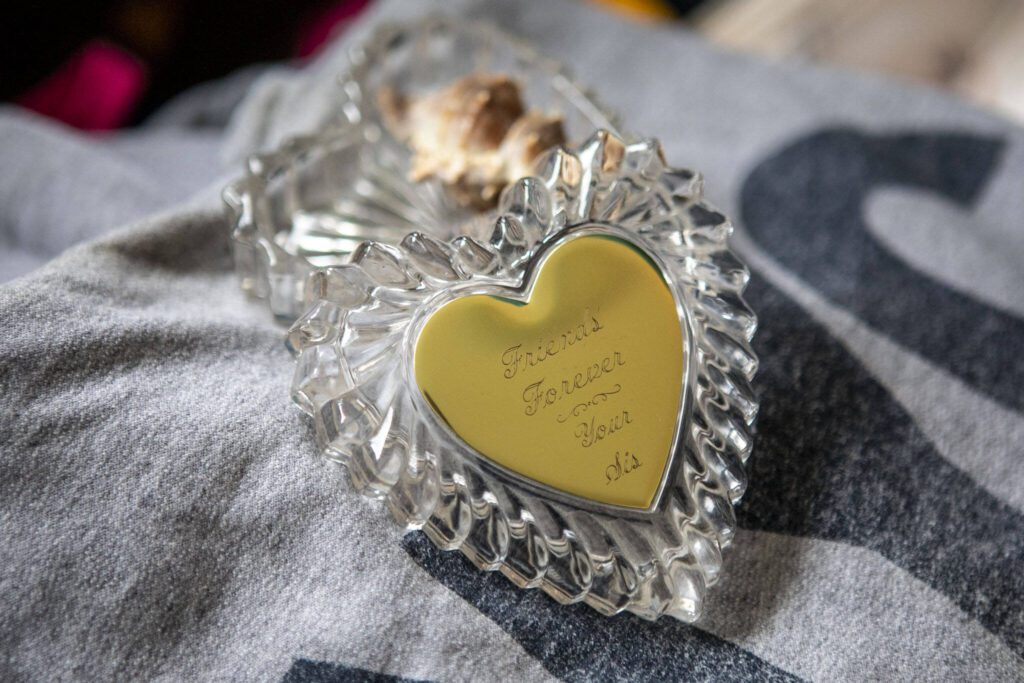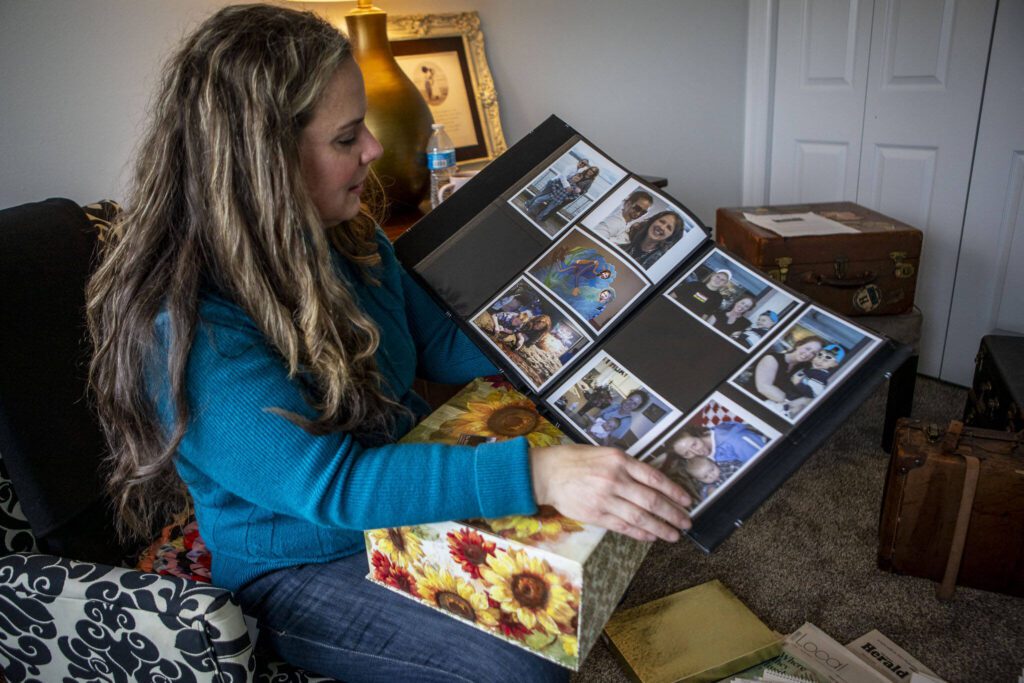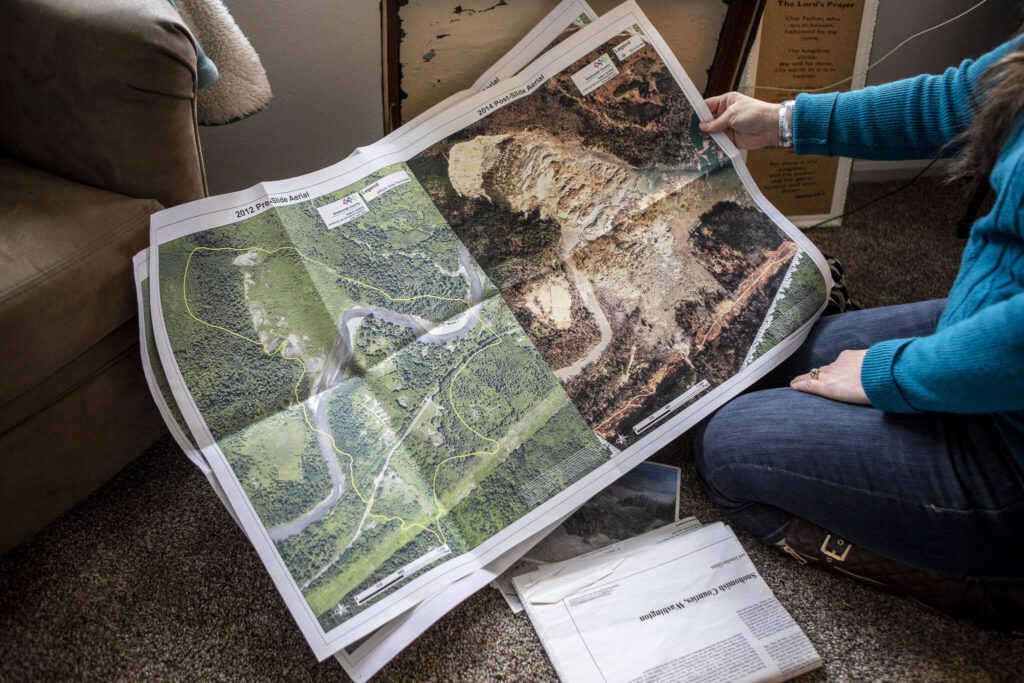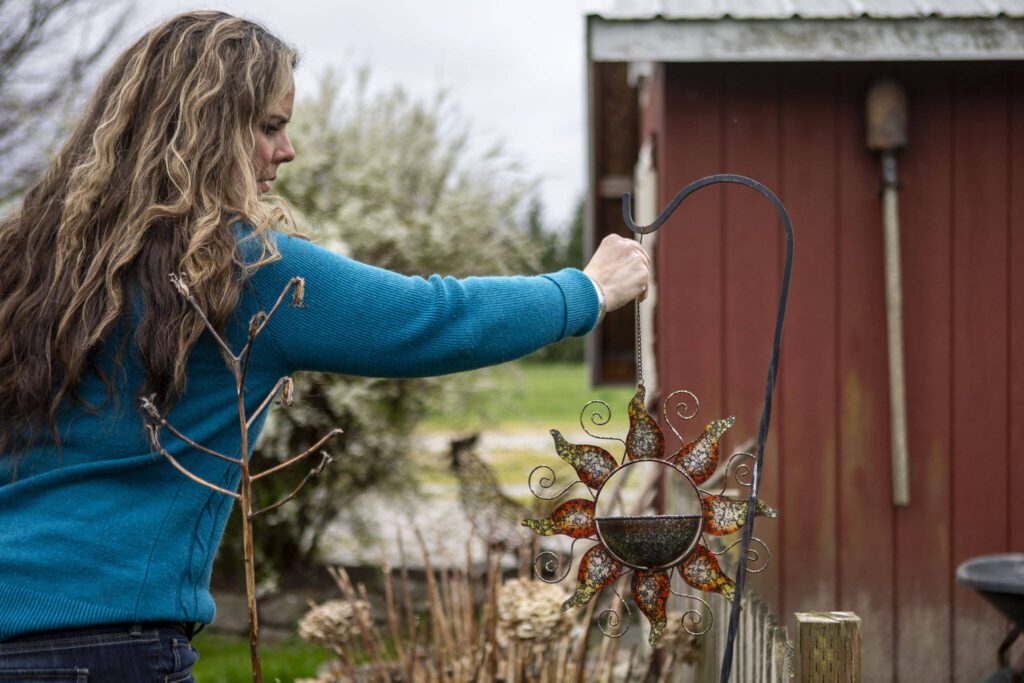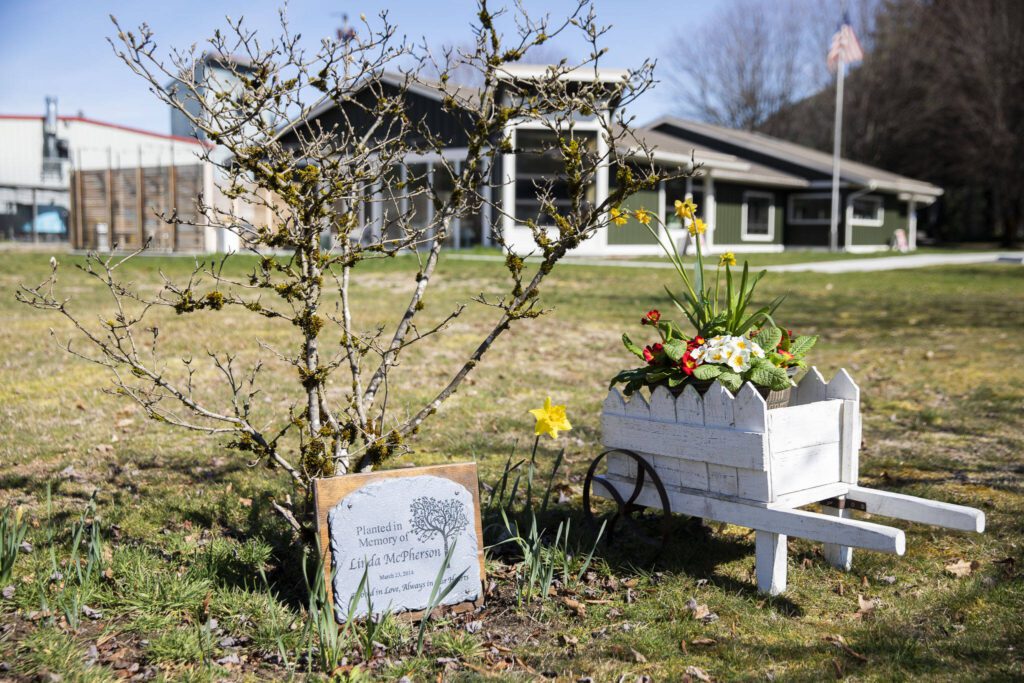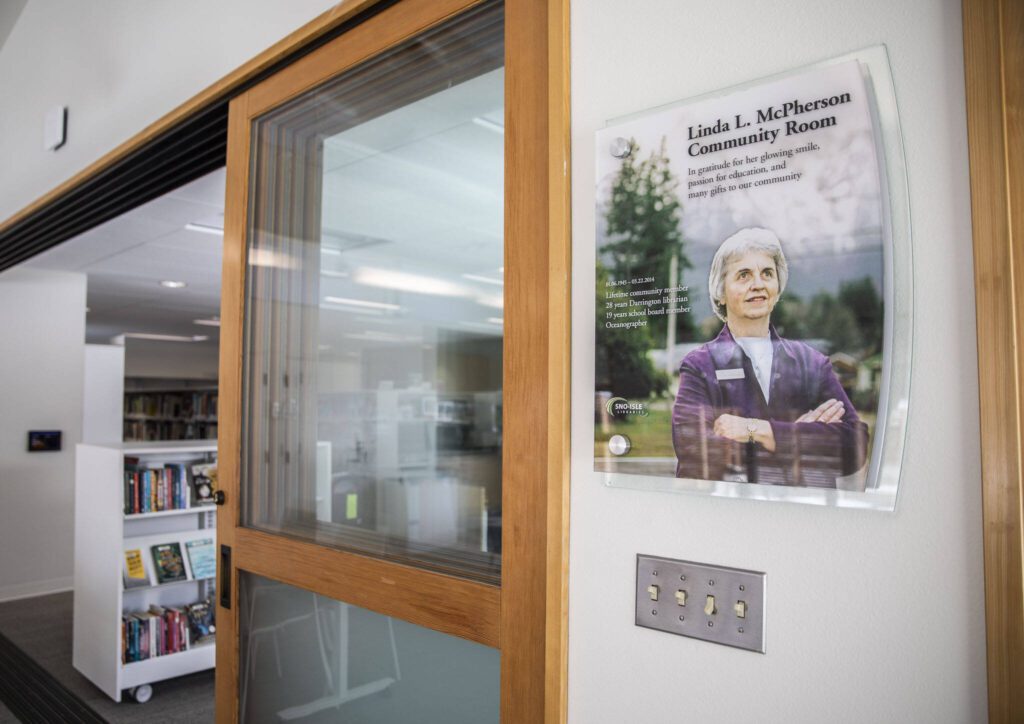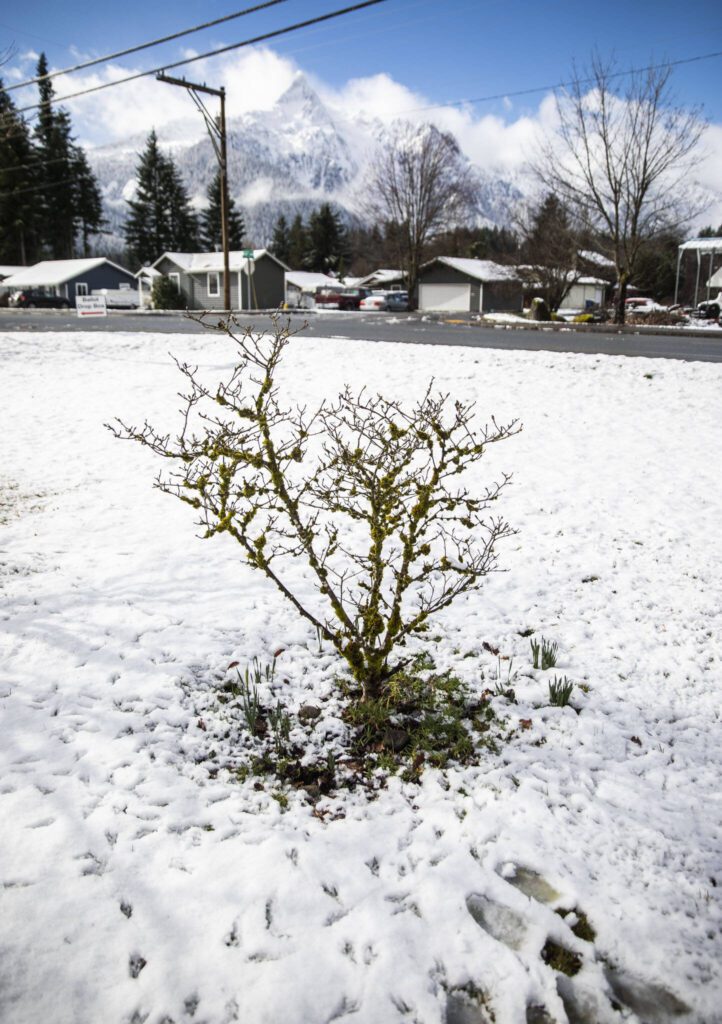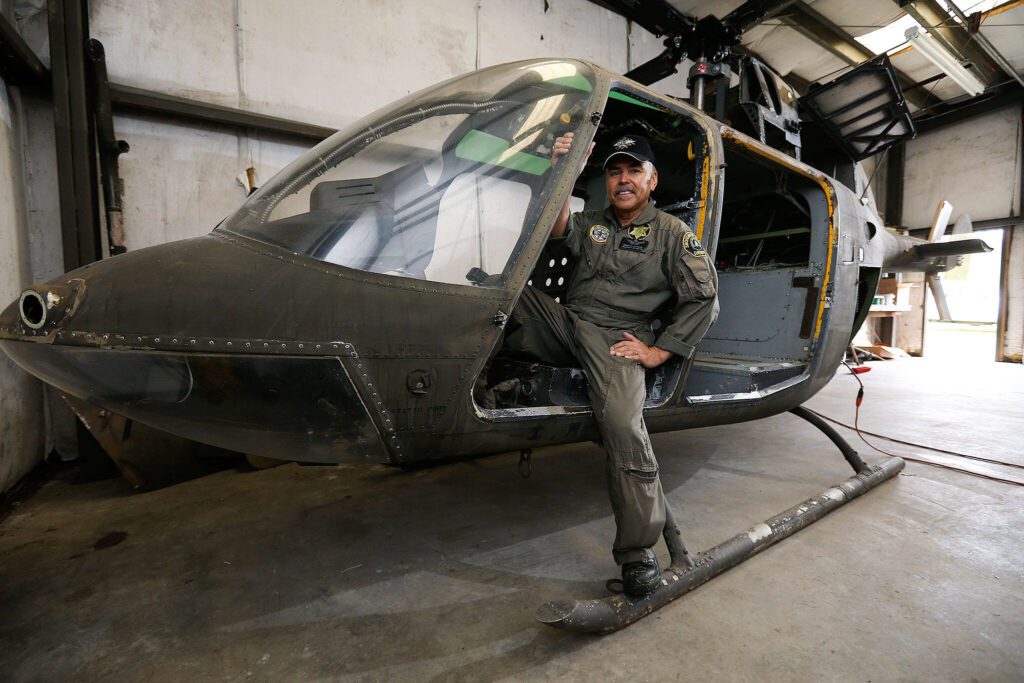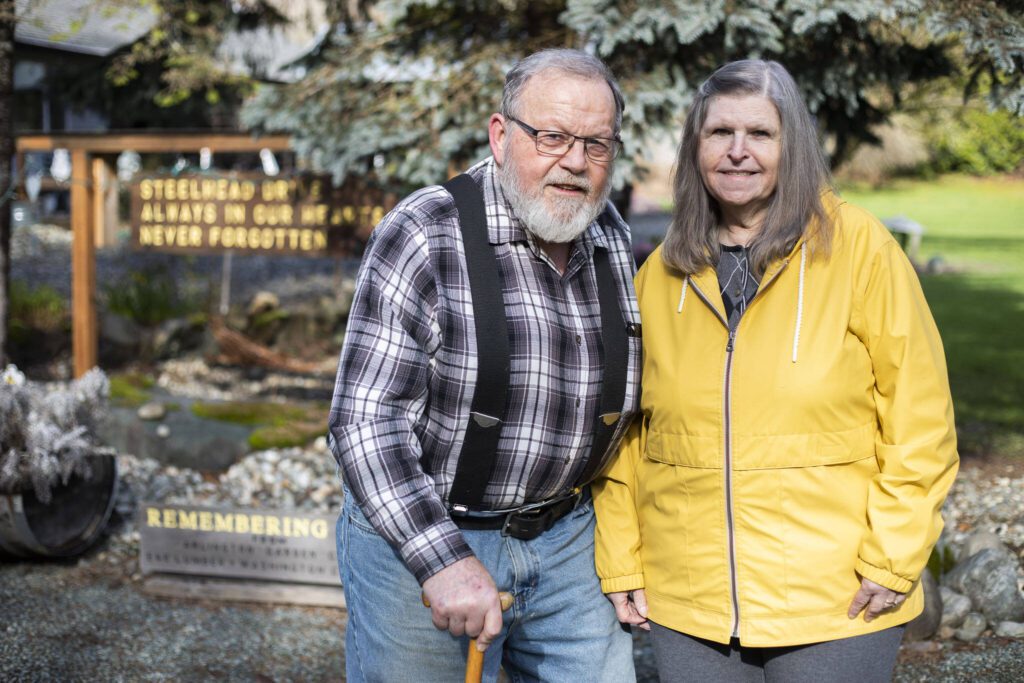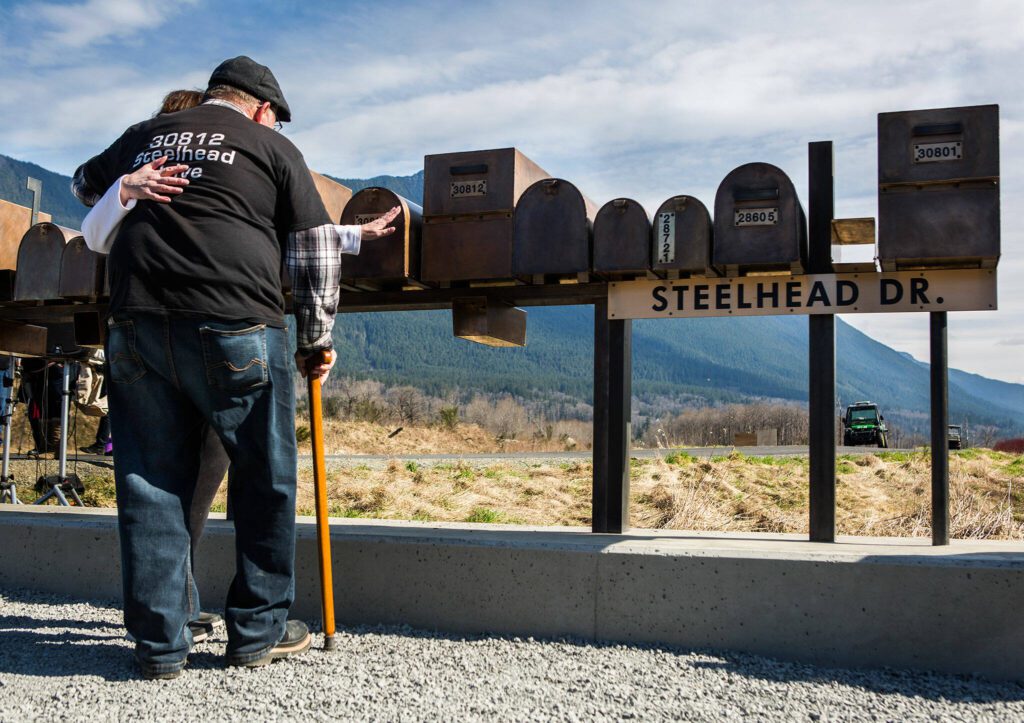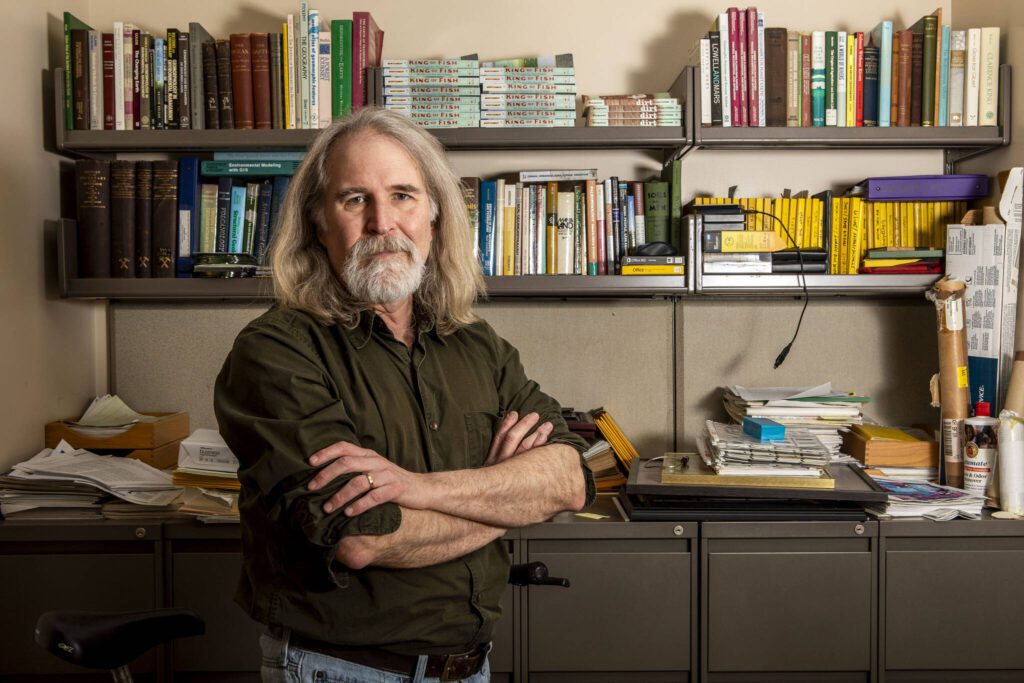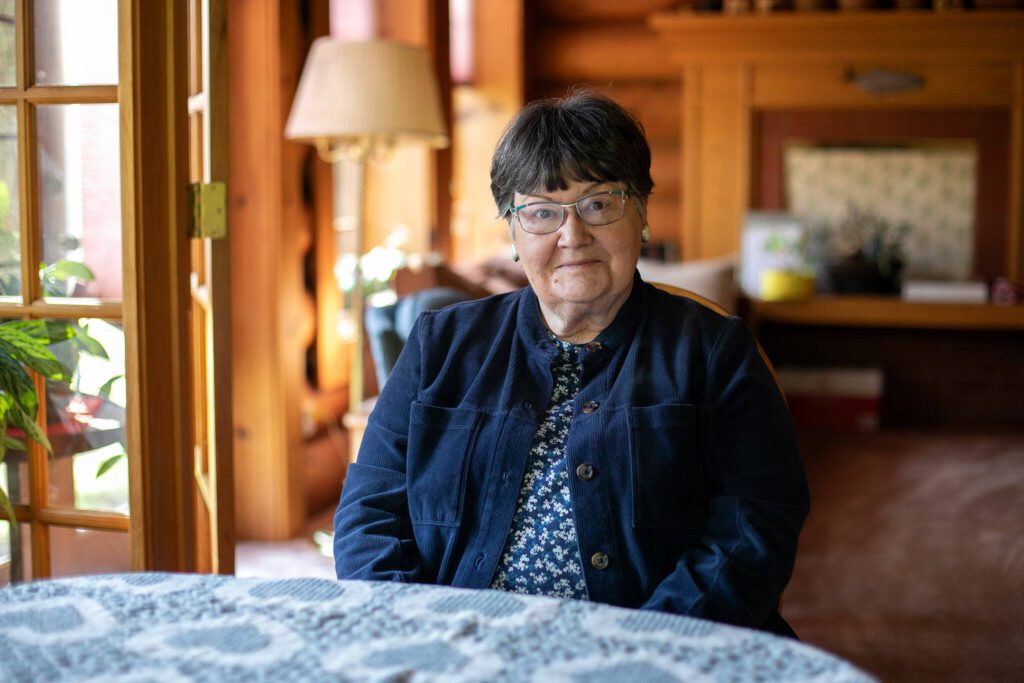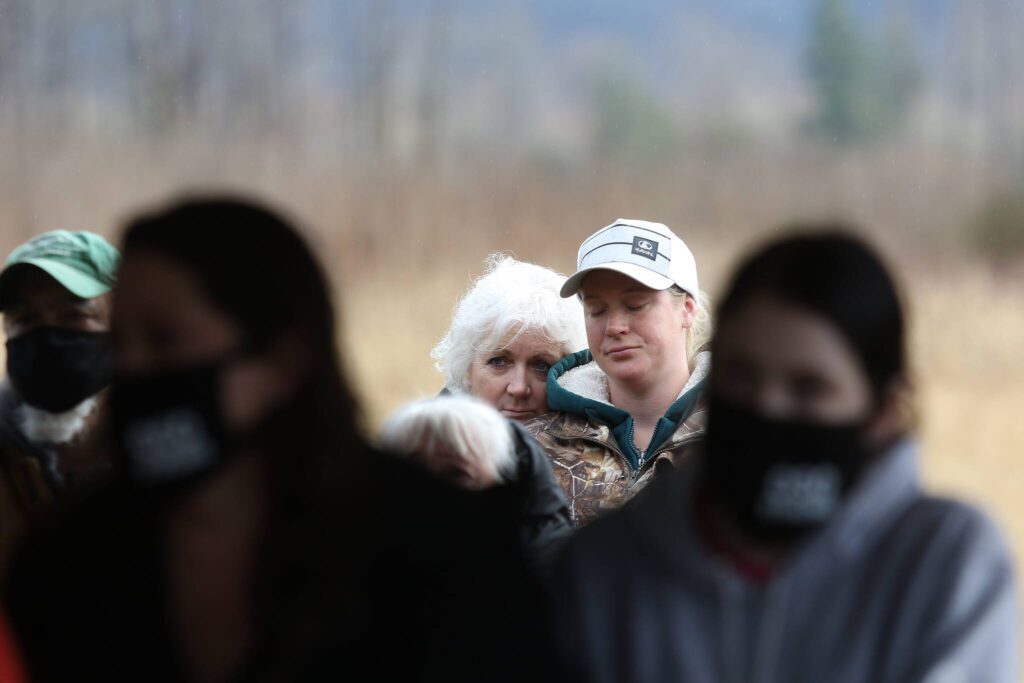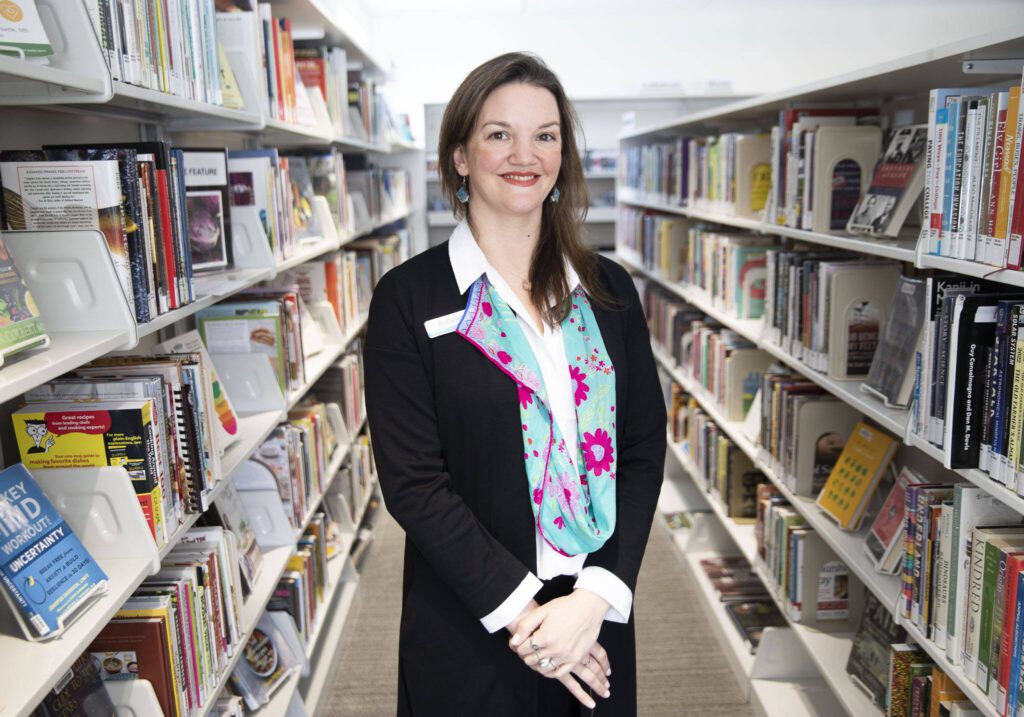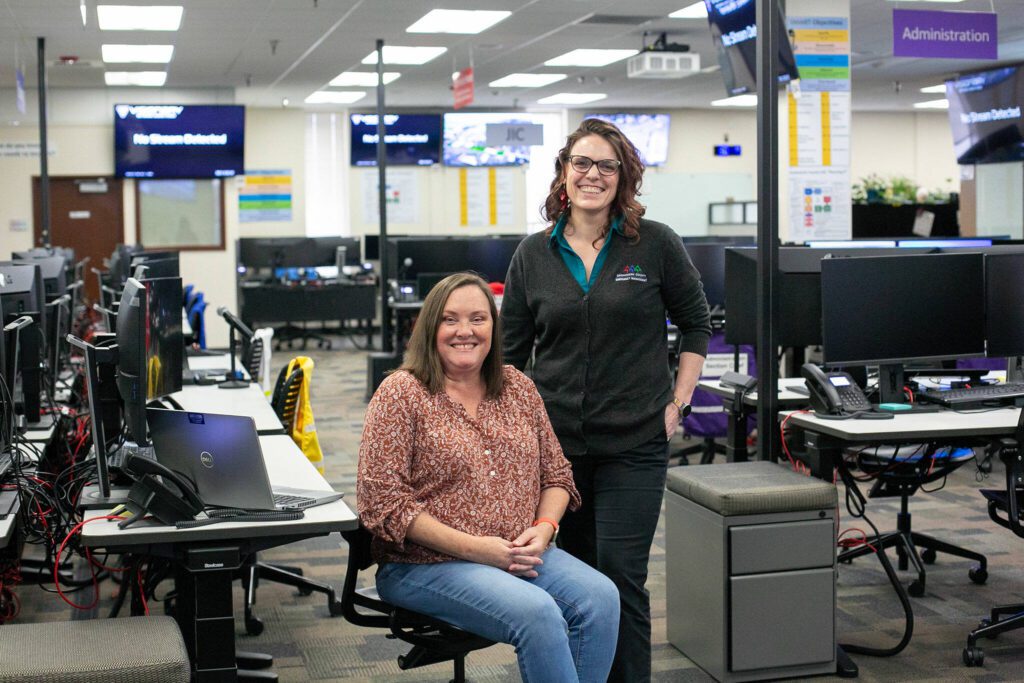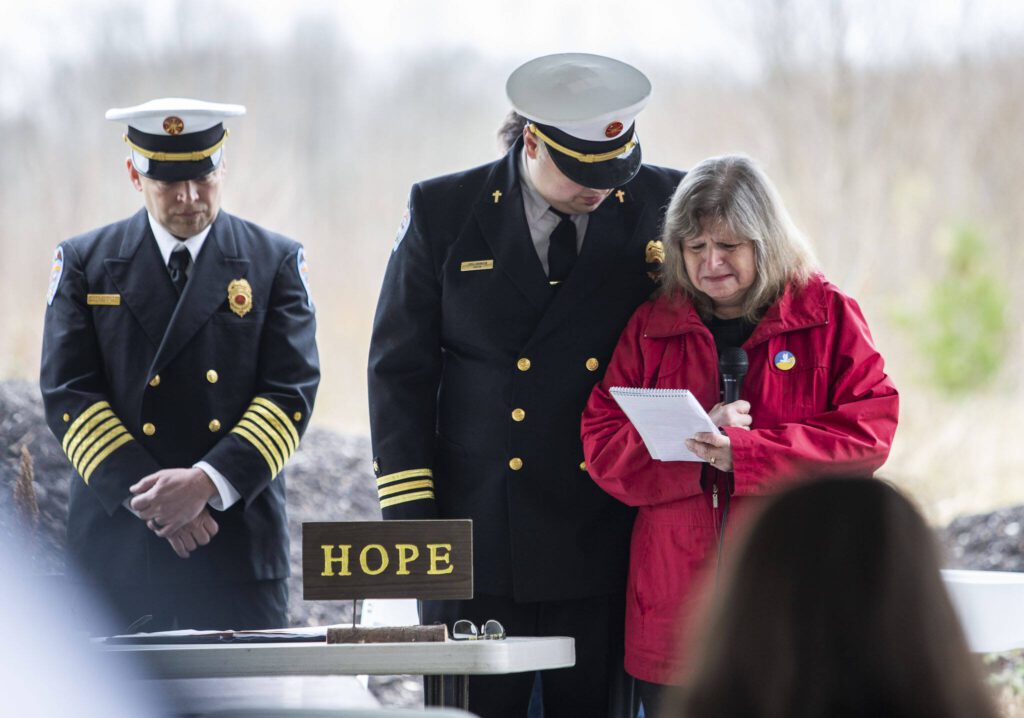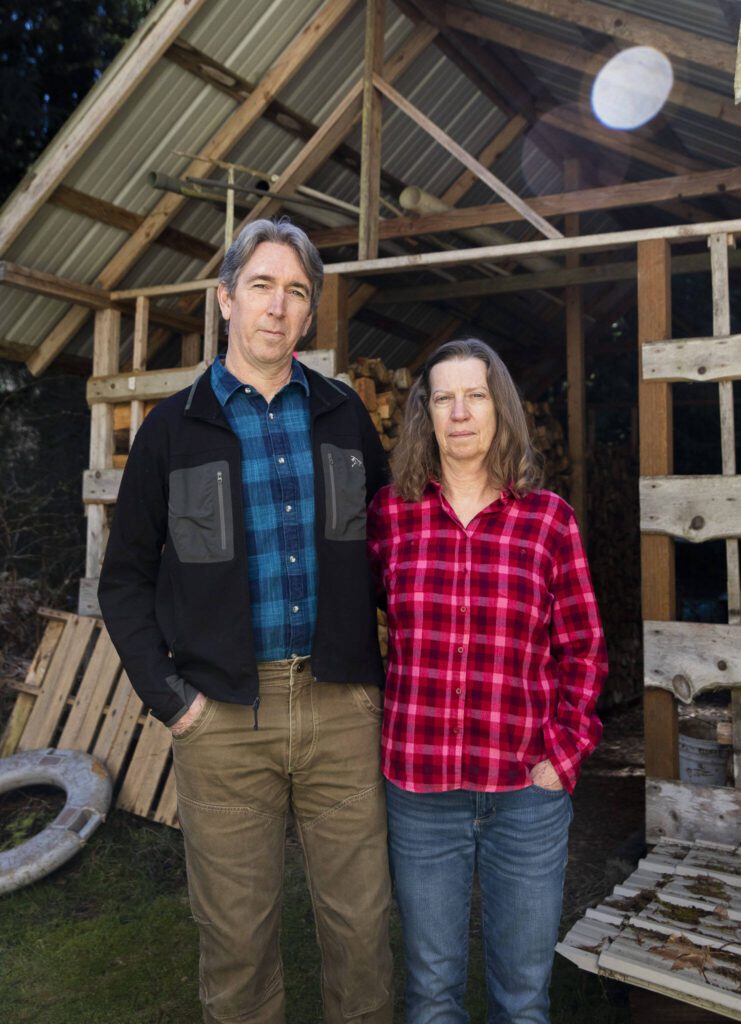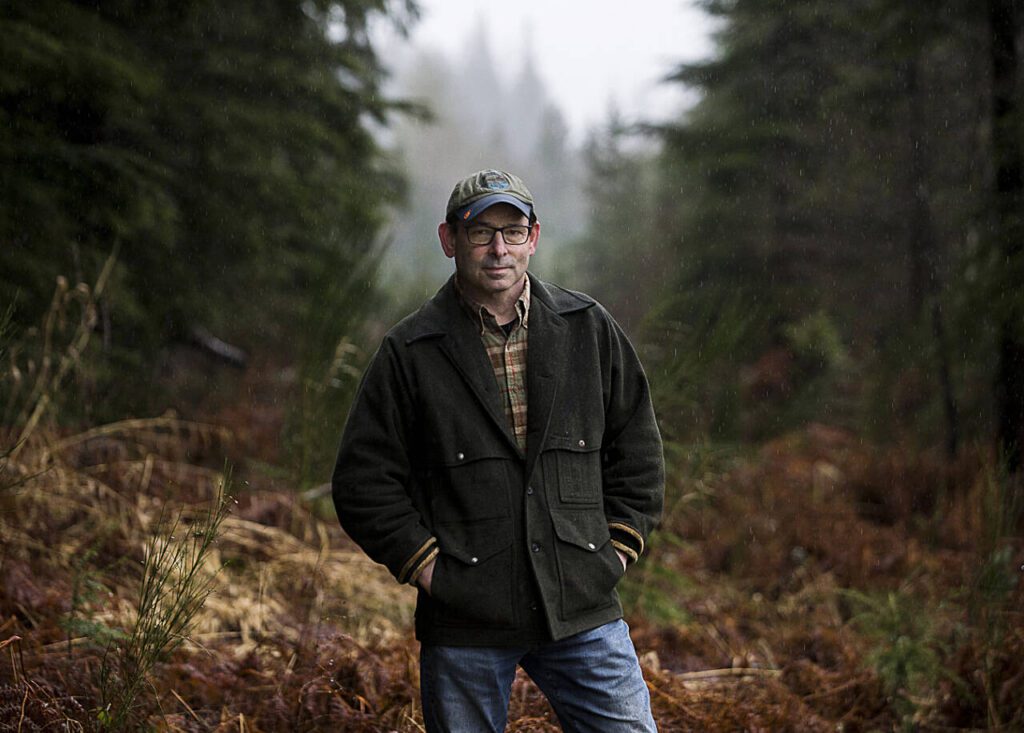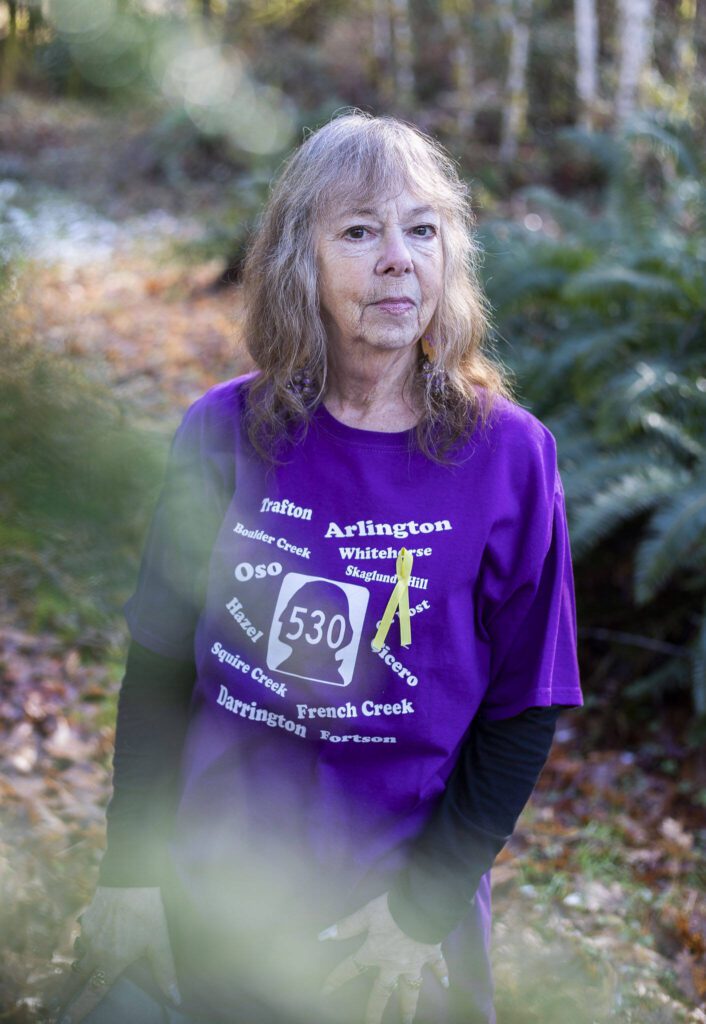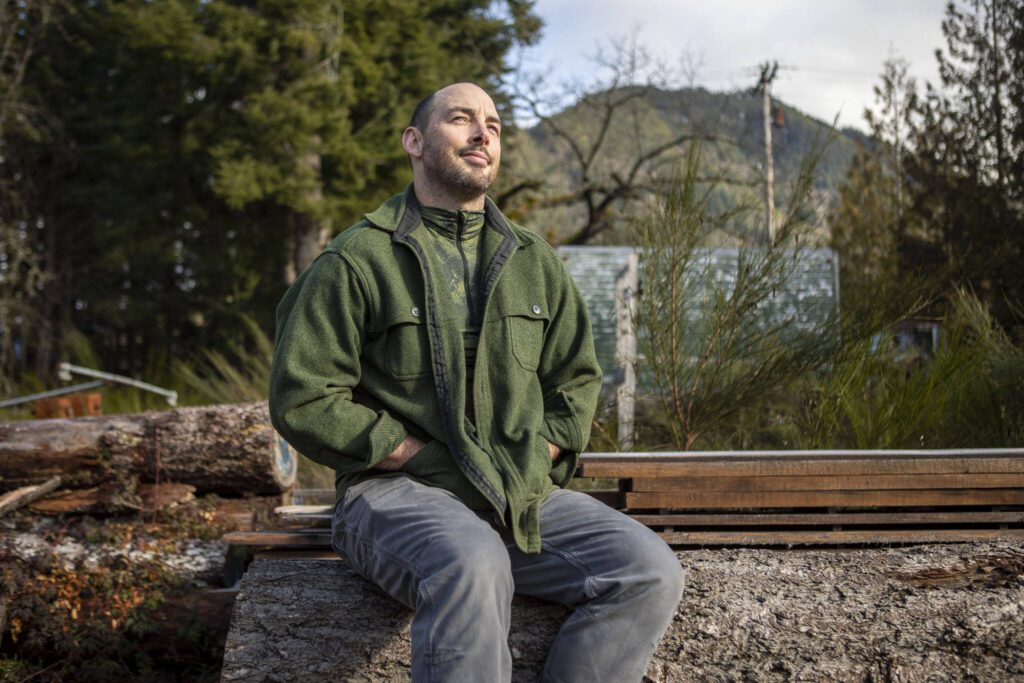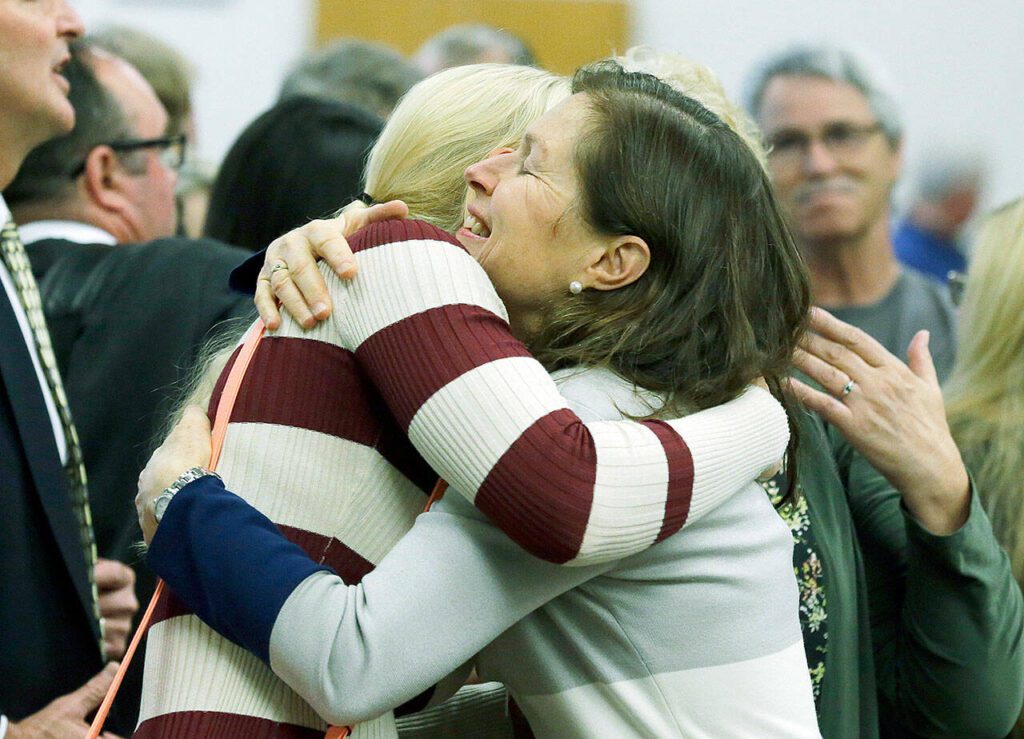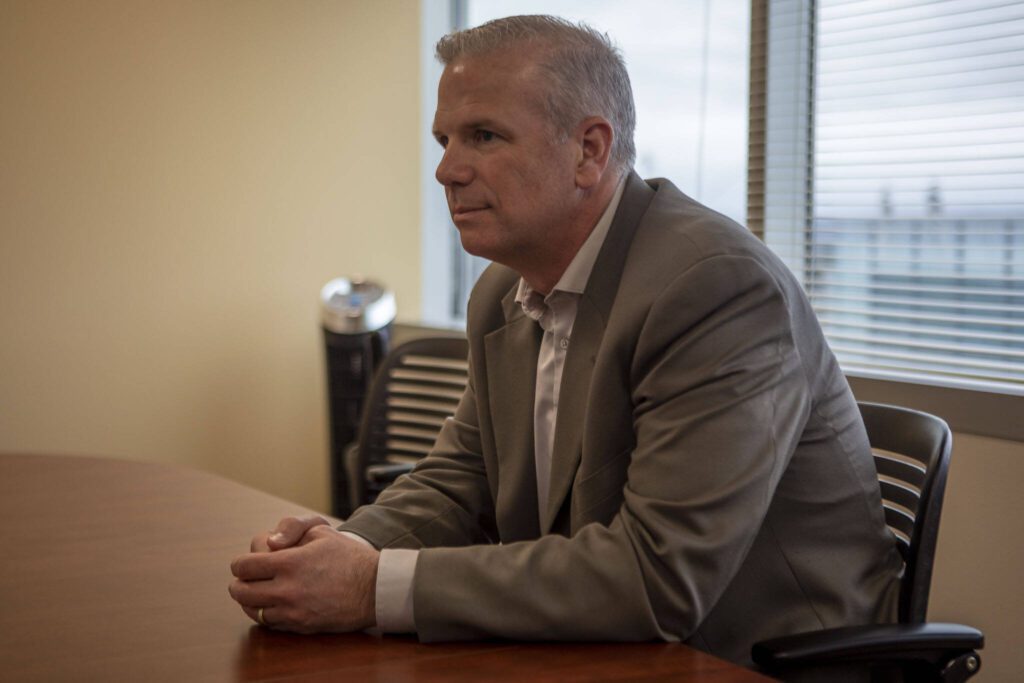OSO — At 10:37 a.m. on a quiet Saturday morning, a roaring wall of mud swallowed the neighborhood of Steelhead Haven along Highway 530.
Trees snapped like toothpicks.
Survivors described the aftermath as otherworldly, like a meteor had struck the planet.
The deadliest landslide in U.S. history claimed 43 lives and destroyed 49 homes in under five minutes on March 22, 2014. For months, rescuers searched the mud near Oso, under the constant whirring of chainsaws and helicopter blades, until the remains of each victim had been found.
Ten years later, saplings grow in a debris field that covered a square mile along the Stillaguamish River’s north fork. This year, The Daily Herald spoke to dozens of people touched by the slide — family members of victims and survivors, first responders, elected officials, journalists and others — to document the story in their words.
Some quotes were condensed or edited for clarity.
SLIDE
Nancy Rambo (former fire commissioner secretary): That March, we had more rain than we’d ever had.
Julie Petersen (sister of slide victim Christina Jefferds, great aunt to victim Sanoah Huestis): Something like 30 inches in a week.
Tim Ward (survivor, lost wife Brandy to the slide): The day of the slide was one of the first days that we had sunshine without clouds. I assumed it was going to be a good enough day that I was going to go out and work in the chicken yard.
Diana Bejvl (mother of slide victim Alan Bejvl): One of the people who lived down there said that they remember seeing Thom and Marcy Satterlee, Alan and (his fiancee) Delaney (Webb) around the campfire having coffee that morning. One hour before the slide, Alan messaged Delaney: “What do I need to make me happy?” And he said, “You, you, you, you and you.”
I had Alan’s favorite meal, chicken enchiladas, cooking. We were waiting for him because he should be there in 10, 15 minutes. We expected him to come. We were gonna spend the day together, go for a walk, have lunch, just enjoy each other’s company.
Jonielle Spillers (wife to slide victim Billy, mother to victims Jovon, Kaylee and Brooke): We were planning on going out in the mountains that day to look for snow as a family. You never know when it’s going to be your last hug or kiss on the forehead before you go to work.
Ward: I went into the bathroom, took my wedding ring off, my glasses off, stood setting the (shower) temperature. We heard what we thought was the jets outside. About once a month, the Navy would fly up the valley. Well, that’s not what it was. It was the mountain giving way.
That’s the last memory I have being on Steelhead Haven: standing under a door jamb in the hallway, reaching out with my hand toward my wife as the house got swept away. The last thing I saw was her reaching out toward me, and I was reaching out toward her, and she disappeared.
Willy Harper (Oso fire chief): I was actually mowing the lawn. My wife came out and was waving at me because I’d left my pager in the house. I came up to her and she said, “You have a fire call.” It said, “Roof in the road,” which was kind of weird. That’s all it said. So I hopped in my rig and headed up.
Gail Thompson (Steelhead Drive resident): Our daughter Jennifer said, “Mom, something happened on Steelhead Drive. I don’t know what it is.” We thought it was the beaver pond that had burst.
Bill Quistorf (chief pilot, Snohomish County volunteer search and rescue team): SnoHawk10 was getting ready to go on a training flight. That’s our rescue helicopter, and they had a full crew onboard. And they were just about ready to go and the search and rescue deputy came out and said, “Hey, there’s a report of a mudslide on 530.”
Gail Thompson: We left maybe 10, 15 minutes before.
Ron Thompson (Steelhead Drive resident, Gail’s husband): Our place was 30 to 60 feet deep. Covered it.
Gail Thompson: They said it happened in about 60 seconds.
David Montgomery (geomorphologist, University of Washington): It moved all the way across the valley and essentially erased the valley floor.
Rambo: It was just slush and mud underneath. It just all came down.
Irene Kuntz (sister of slide victim Linda McPherson): (Linda and Mac McPherson) were sitting in recliners next to each other, reading the paper when it happened. He was buried, but he got himself out.
Ward: I was 500 yards down the hill, about 15 feet below the surface. I had been in the military. We were taught survival, evasion, resistance and escape training. I didn’t know where I was, but I realized I wasn’t in Kansas anymore. I went from my head to my ears to my nose, down my chest doing a full body assessment. That’s when I got down to my waist and my legs, and they’re pointing in the wrong direction.
John Hadaway (brother of slide victim Steven Hadaway): I shot (Steven) a text, “Hey, give me a call. I heard there’s a mudslide up there.” Nobody ever thinks that anything’s gonna go wrong until it does.
Quistorf: That whole hillside had collapsed. They started right into rescue mode. They started pulling people out and helping.
Ward: There was probably a dozen people there. They spent the next two or three hours digging me out.
Harper: It looked like some mud and a roof, kind of strange. Then somebody yelled out, “There’s a baby in here!” and a couple of the firefighters that showed up after me, myself and a few civilians went in and helped pull out Duke and Amanda (Skorjanc, now Suddarth).
Quistorf: (Another pilot) said there were 20-some homes out there. And I said, “Where?” and he said, “Right here!” I looked at our moving map that shows exactly where we’re flying. It showed the development that we were flying over the top of. And there was nothing left.
Jonielle Spillers: I remember being scared and crying and not knowing exactly what happened. I told myself, “Maybe my husband’s out helping.” That’s the kind of person he was.
Diana Bejvl: We tried to call, then we realized our cell phones weren’t working. My oldest son, who’s sensitive to the world, goes: “Alan’s gone.”
John Lovick (then Snohomish County executive): I was giving a speech. As I was leaving, my phone rang. It was John Pennington, the director of emergency management. I answered it and he said, “Boss, we’ve had a mudslide.”
I went ahead, laid the phone down and I merged on the freeway. As I merged southbound (near Smokey Point), I look to my left. I could see emergency vehicle after emergency vehicle going north. Fire trucks, police car, state troopers’ cars, and it brought me back to April 18th of 1980, when we had the Mount St. Helens eruption.
Petersen: On the TV, the news is showing helicopters flying over the slide. I’m not connecting the dots. I think all of us have thought, “Thank God, it’s not me. Thank God it’s not my hometown.”
Abbie Pearson (daughter of slide victim Michael Pearson): I didn’t even put two-and-two together that day. I had just had my youngest, she was six weeks old. I saw it going all over the news. I had not talked to my dad in probably a few months. A friend of mine was like, “I thought your dad lived up there? You should give him a call.” I called and it just rang and rang. He was very old school, he did not believe in cell phones. He did not believe in voicemail even. I was starting to freak out at that point. What if something happened?
Joel Johnson (then Oso fire chaplain): We had just gotten home from bringing our firstborn daughter back from the hospital. I told (my wife), “I got a call, I’m the closest one, nobody else is available. I’ll be back in a couple hours.” Thirty-eight days later, I finally got my first break.
Quistorf: The rescuers, the firefighters on the ground were locating people that were trapped. Civilians were in the area helping their neighbors, some civilians who were driving by stopped to find people and get them out. Our rescue helicopter and the Navy helicopter would transport the injured subjects over to a clearing we call LZ Alpha — Landing Zone Alpha — a pretty big clearing.
Dayn Brunner (brother of slide victim Summer Raffo): I told my mom, “What do you want me to do?” She said, “Go get your sister.” I had to do it. There’s helicopters flying around telling us we need to get out. One was yelling, “You’re gonna be arrested.” But I didn’t care.
Johnson: When you would go out, you would duct tape your boots and your pants together so that mud wouldn’t get in, and so that if you fell down into some of the soupier stuff, you wouldn’t lose your boots.
Harper: A couple other civilians decided they were gonna go tromping through the mud, which was literally up to our waist. It was super hard to walk in. They headed out and found (4-year-old) Jacob Spillers. They airlifted him out, and then most of the other people were rescued on the Darrington side. I don’t think anyone else on this side lived. There was one guy off to the south up against the hill, and somebody was waving a mirror. I remember seeing that thinking, “What the heck am I looking at?” Because it kept moving. They were trying to signal us down. The Darrington side was drier, because it’s a little higher. But on our side, it was just Amanda (Suddarth and her son) Duke, and Jacob (Spillers).
Jonielle Spillers: I remember walking into that hospital room and seeing him. I assumed he would have broken legs or arm or some major medical issue. Seeing him on that bed, the blanket wrapped around his lap, it’s like in the movies: You see people talking to you, but you don’t hear them. All you can think about in that moment is that your baby’s OK. If it wasn’t for Isaac Hall and Quinn Nations and SnoHawk10, he wouldn’t be here. It gave me something to live for.
Gail Thompson: A guy came up to our car and said, “You can’t get through here.” Ron said, “Well, we live there, we live on Steelhead Drive.” He said, “There is nothing left of Steelhead Drive.”
We were trying to to grasp our minds around it and he said, “I want you to go back to the Darrington Community Center and report that you’re not missing, because you’re on the missing list.”
Diana Bejvl: We went down to the community center. All these people were there, all these people were crying. And I’m going, “Whatever’s happened is huge.” And when people see you and either turn away, or start to cry, you’re going, “This is not good.”
Quistorf: Within the first few hours, everyone that was injured and survived got pulled out of there. We kept going back and trying to find something, somebody. We stayed until it got dark. By 7 p.m., we were the last aircraft out there.
Rambo: Every time I saw that helicopter had landed, I wondered who they found, or who they didn’t find.
AFTERMATH
Gail Thompson: We went to (our pastor’s) house and spent the night. We didn’t realize he didn’t have any reception. We went to turn the TV on. There was nothing. Radio didn’t work. We had no idea what was going on that whole time. At 4 o’clock in the morning, finally Ron said, “It’s getting light out. We need to go find our neighbors, we need to find out what happened.”
Asheley Bryson (now Sno-Isle library branch manager in Darrington): They didn’t have power. They didn’t have internet. They didn’t have their phones. They came to the library to find out what was happening.
Our IT department set us up with a bunch of laptops in our meeting room so that people could reach out to loved ones and let them know that they were OK. We also have a very brilliant engineer who constructed a cell tower just right out here in our library.
Scott Morris (Darrington Historical Society president): The earliest days, so many Darrington folks showed up to start digging through the mud. There was nobody hardly out there, as far as the official response. They were still getting organized, which, if you understand how those things move, it’s kind of understandable, the slow response. Not necessarily forgivable. There was a lot of seething anger about, “Where the hell is everybody?”
Petersen: It was probably three to seven days of the (government) arguing with the locals. “No, this isn’t protocol. You don’t let citizens in. They’re not qualified.” The loggers and community members didn’t stop to wait for the bureaucracy to decide who is allowed to save a life.
Rikki Fruichantie (former Herald reporter, then known as Rikki King): Even though emotions were high, and the stakes were so high, this was community history, and it needed to be documented. The families and the first responders deserved that accurate, fair portrayal of what they were going through. (Herald photographer) Genna (Martin) had pictures showing body bags the first or second day. The newsroom made the decision that we weren’t going to run it yet. When those did run, that was when we realized the outside world needed to understand the loss.
Harper: I was in the station coordinating the different agencies, the volunteers and really pushing to keep the family members and local civilians able to go out in the site and dig.
Petersen: The Oso Fire Hall was a flood of people wandering around aimlessly, not knowing anything, what to do, who to talk to.
Rambo: We fed 200 people out of that little fire hall. Every day, breakfast, lunch and dinner.
Diana Bejvl: I remember one time going over the fire department, and (Darrington Mayor) Danny (Rankin) was there. I was crying and pointing him really hard with one finger and hitting his chest: “You find my son.” And he was crying. He goes, “We’re trying.”
Dan Rankin (Darrington mayor, elected 2011): I still talk to the three guys that I spent the first three days in the command center with. There was huge sorrow, there was huge tragedy. But as bad as the accomplishments were, they were still celebrated and honored. If you were on-site in the days after, and you said there were 43 people out there and you were gonna find them all, there isn’t anybody that wasn’t going to call (B.S.) on it. It was an impossible feat.
Dara Salmon (now deputy director, Snohomish County Department of Emergency Management): We did a whole lot of resourcing — trying to find the supplies and equipment that they needed on the scene — locating it, paying for it and getting it here. I think waders were at a premium at one point and duct tape another time.
Brian Collins (research civil engineer, U.S. Geological Survey): There was this question of, “Is it going to continue to move?” That’s a problem, because we have all these people working in the distal end of the landslide. So if it does move again, are they in danger?
Eric Stevick (former Herald reporter): They had a place for people who had been rescued or displaced, Post Middle School in Arlington.
Gail Thompson: The auditorium was full and the Red Cross people came in to sign you up for help and medicine. And people just looking for people. We were there for days. We just sat there and cried with the neighbors.
Petersen: I saw a classmate Traci Toussaint (Gunderson) and her husband Aaron who used to live on Steelhead Drive, but moved months earlier. We just looked at each other and didn’t speak a word. We embraced in a hug and cried.
Hadaway: We would come home on Sunday, drop off dirty clothes, see my son and my wife. Monday morning, bright and early, go back up and stay up at my sister-in-law’s house. The rest of the week we would go out and search.
Kuntz: (My family) was going through some of the rubbish and the buildings that were demolished, and someone heard the dog whimper. They had the dog for about seven, eight years by then. Boy, when they found that dog, that was their lifesaver.
Johnson: Many early mornings. Many late nights. When we would find somebody’s loved one, sometimes I would meet family members, maybe extended family members and share with them the news. Or if we recovered a significant piece of their family’s belongings.
Diana Bejvl: The only one reason I was down there is that when they found Alan, by God, his mom was going to be there. Hopefully alive. But I didn’t care what condition they found him. I was gonna be there. After five days, you realize he’s not going to be found where you could talk to him or hold him.
Brunner: On Wednesday, we found her car. There was like 15 guys digging, we dug really carefully and I got underneath her shoulders. My son Riley got underneath one leg and then one of our best friends got under her other leg and we pulled her out, laid her on the tarp and I said my goodbyes. Then the helicopter came in and took her away.
Quistorf: It took a long time for the ground teams to search tons of mud and debris trying to find the victims that didn’t make it.
Brunner: I was right there with them for 67 days until we got every last soul out of that mud.
John Hadaway: If it wasn’t for the community and the loggers, everybody would not have been found.
Marla Skaglund (Skaglund Hill resident): Every time they’d find a body, everything shut down. Everything got quiet.
Pearson: The sheriff’s department called me. They said, “We’re not 100% sure if this is your dad or not, but we need you to do a DNA test to verify.” So I did. And that was that. When they figured out that it was him, he was the John Doe that was in pieces. And I just collapsed. There was so much regret, there are so many things that I wish were different. Then you’re reliving your childhood. You’re reliving things you can never change.
Diana Bejvl: I got the phone call when Alan was found. The only thing I remember, I said, “Lie to me if you have to. I need to know it was fast.” And he goes, “I’m not lying. It was fast. You didn’t even know what happened.”
(Alan’s fiancee) Delaney was found 4 feet right underneath him. It took a couple more days before they found her.
Ward: They came back to me and said, “We found your wife.” I said, “Can I see her?” They said, “You don’t want to see her.” It’s forever in your memory.
But that’s OK. Because in my memory also is the beautiful 18-year-old girl who married me when I was 21, who gave me two beautiful daughters. Thirty-seven years of beautiful marriage.
LAND THAT WALKS
Barb Tolbert (then Arlington mayor): At the end of every day, I would go to the Red Cross shelter — first it was in the school, and then it was in the Smokey Point Church — to hear the briefing that the families were getting from the first responders about what was discovered that day. I felt it was my responsibility to do that. I would go home full of emotion and pain for people. That would just make you work harder the next day.
Stevick: The grocery parking lot up the way became this unofficial place where people would gather to see if there’s information about survivors. I met a lot of people looking for brothers and sisters and family members there.
Morris: Early community meetings were a bunch of pointing fingers at the officials who, I think, really swallowed their defensiveness and listened.
Jay Inslee (Washington governor): We tried to be as transparent with people and be timely to get information to the families. The pain that they were going through, the trauma, was beyond human imagination.
Dan Rankin: When we were doing our public meetings, there was one ground rule: You tell the truth. And you tell the truth in a way that you would want to be told. A friend of mine asked to talk at one of our community briefings. She talked about what that area meant to her and her tribe. It was a gathering point between the Sauk-Suiattle and the Stillaguamish, it was a fishing area, it was a lot of things. But the most important and most crucial thing that we didn’t understand, as settlers, was the name of that area: “The Land that Walks.”
Scott North (former Herald reporter): There was no way to drive up to Oso, unless you went all the way up into Skagit County and came down from the north. So they literally were cut off.
Bryson: An hour-and-a-half drive all of a sudden was easily three hours. Considering all that people were going through at that time, a bit of a longer drive was manageable.
Kris Abrudan (spokesperson for state Department of Transportation): The media situation was wild. There were tons of national and even international media. Darrington, as a small town, was not used to that. They really needed a team of (public information officers). On top of everything that was happening, it was really uncomfortable for people to have that level of media presence. That’s why I rolled into town, never having been to that part of Washington. Media basically took over the IGA parking lot and a small hotel parking lot next door. Our PIO shop was based in the Darrington firehouse in one of their fire bays. It was pretty rudimentary. They cleared out a truck so that we could have a desk.
Morris: We had like nine satellite trucks in the IGA parking lot, and everyone trying to interview you while you’re buying groceries.
Shari Ireton (then Snohomish County Sheriff’s Office spokesperson): I did phone interviews with everybody from Al Jazeera to the BBC.
Jonielle Spillers: My friend messaged me, “Hey, Jake’s on the front page of the National Enquirer.” I was like, “What?” We went to the local grocery store and there he was, the image of him being rescued in the helicopter in his underwear.
Dan Rankin: The modus operandi for media for a long, long time, before the slide, was going to the grocery store, to the tavern and finding the most rough-and-tumble, harsh-talking individual they could find to get a quote. I think we’ve changed that dynamic. I think it’s very important to realize rural folks aren’t folks with bad dental plans who talk funny. We’re humans. We’re people. Some of the most brilliant people that I’ve ever met I grew up with here.
Abrudan: I was sort of a press corps liaison the day of the Obama visit.
Lovick: He was getting on Marine One to fly over to the scene and we jumped in patrol cars. I said to him, “Mr. President, this is a horrible disaster. But you’re gonna find that this is a resilient community.” He said, “I’ll find out, I’m glad it is.” Three hours later, the president went out and met with families and then we met him at the fire station. And he walked up and said to me, “Executive Lovick, you are exactly right. This is a resilient community.”
Abrudan: We had a small school bus driven by the National Guard to get kids to school. There was an extensive amount of work that needed to be done before we could repair the roadway. We had to find it, first.
Morris: Five weeks after the slide, they made a one-lane connection through the power lines road. Loggers pretty much built the road without permission — stopping their paid work to volunteer for three days, nonstop, building a road that could connect the east and west side for emergency personnel. Eventually that became the road that ferried all of us. On the half-hour, it would switch west or east. So we all called it catching the ferry.
Skaglund: You had to have a special card in your window, because at Oso Loop Road on this side, there was a guard.
Harper: Mayor Rankin reached out to me and said, “Before we put people in cars back on this roadway, I think we need to have a moment with it.” Which was just realizing how integral the community had been in search and rescue efforts. The general feeling was that it could feel pretty traumatizing getting back on that road. And so WSDOT hosted an event. We tried to lead with families first, and then getting the community back out there. We had a moment before they put their cars on it. Almost 500 people showed up to just walk the road.
GRIEF
Ron Thompson: You got tired of hearing, “Well, how are you doing?”
Gail Thompson: Because then you have to go there. So we would just say, “It’s good to see you.” And that seemed to be the right thing to say.
Diana Bejvl: I remember going outside. I felt like I was an alien in this world. I couldn’t remember what a tree was called. Your reality is so amazingly altered. One day I sat on the couch, just sat there. Next thing I knew it was dark. How many hours was I sitting on the couch? I have no clue.
But I’m not there now. I know what a tree is. I don’t spend hours on the couch. I just carry a constant grief with me.
Bryson: Sadness is probably the primary emotion for me. There’s some anger, too, that there was ever even allowed to be a neighborhood there.
Oak Rankin (executive director of the Glacier Peak Institute): A lot of people we know die in logging and timber accidents. Death is a mainstay in our community. It happens from time to time, people get injured, people get hurt. But we don’t see the same thing with really young kids. A lot of people really struggled with that portion of grief.
Jonielle Spillers: It gets harder as time goes on. You miss out on those special marks, like my oldest son turning 21 or getting his driver’s license, potentially getting married. And my daughters, Kaylee and Brooke, they were young. Kaylee was almost 6 and Brooke had just turned 2.
I’ll still be dealing with the loss of my children, my spouse, friends, probably to the day that I die.
Harper: I spoke to an individual a few weeks ago, and he said, “Well, I haven’t had a nightmare in a year. So that’s a good thing.” There’s a lot of (post-traumatic stress disorder) that was caused by it. I know some people believe in therapy, and some don’t. If we hear people that are having issues, we try to push them towards talking to somebody.
A buddy of mine said he wakes up holding this dead little girl in his hands, because he’s the one that pulled her out of the mud. It’s not something that any human should have to see. We have people that go to war, but they’re prepared. Nobody’s ever prepared to see that, but at least they have some training to know how to deal with it. When you have civilians coming in that have no resiliency training, or outreach programs to go through, they have to do it on their own. Unless they reach out, there’s no way to know if they’re even dealing with it.
Tolbert: It’s a such a big trauma. I can never approach that time without feeling the emotions. I felt like my job was to push those emotions aside and focus on the people, focus on the system, focus on recovery.
Pearson: I was going through those memories, and replaying, and having nightmares of the slide for years on end. I was so shut down. And I kept being told, “You need to talk to a grieving counselor.” I couldn’t do it. It was reliving it every single day.
Diana Bejvl: Darkness still creeps in, the morning of and this month in particular. But when that happens, I tried very hard to focus on how the whole world came together to help us. And Darrington itself is a force to be reckoned with.
Jessica Pszonka (lost six family members to the slide): The one thing that did help early on, there was a grief counseling group that was run by Peggy Ray (and Ray’s husband Nathan). They did work with a lot of the families. They were like a family representative for us.
Gail Thompson: All the families, all the survivors would meet at the Connection Center in Arlington, just to see how everybody’s doing. The more we told the story, the more healing we felt, the more connected we felt. Peggy said, “Well, what is it that you want out of our time together?” We all said, “Hope. We need hope that we’re going to be OK.”
Bryson: When you all go through something big like that together, you can’t help but be closer in sharing those memories, and talking about the people we lost that we cared about so much.
Kuntz: (My family) loved the farm. They loved being out in the country. And it’s gone except for the memories.
Gail Thompson: I didn’t even really deal with it until a couple years ago. Up at the slide memorial, people were talking about grieving, and I was sharing my story. All of a sudden, I started to cry. I think it was probably about 18 months until I really dug deep and realized the loss that I had experienced.
John Hadaway: Everything’s still raw. They say time heals. Time doesn’t heal anything. You just you learn how to deal with it.
Diana Bejvl: I had a whole wall of family pictures. After I got home, they stayed up for about a week, and they all got taken down. I can’t bear to see them. I do have one picture of him still up. That’s good enough for me right now.
Pearson: I have (my dad’s) uniform, they found it from the slide. I had it framed and I keep it at my house. I have photos of him, and from when I was little, in photo albums. The kids know that they’re sacred, and they don’t touch them without us doing it together. I’m very possessive of those things now. That’s about all I have left of it. Because everything was washed away or destroyed.
You have to get to a point of realizing you have to live your life for the here and now, for the people who are actively in your life and not live in the past. Because you can’t change it. That’s what I finally had to come to terms with. I know (my dad) is proud of me for everything I did within the situation and for my family. He’s OK now. And everyone else will be, too.
Diana Bejvl: We have a beautiful world to live in. One day, this meteor comes out of nowhere and hits us. One piece is gone forever. The other four were thrown out to dark space where it was cold, there was no light. You don’t think you’re ever gonna get out of that. It took a few years. Our love did bring us back together again. But we’re cracked. We have one piece missing. Our orbit is definitely wobbly, we’ll never be steady again. But we’re still family.
Petersen: I have a saying that I now use, that I got from my adoptive Auntie Lyndy when she wrote to me the most meaningful condolence message after the slide: “Grief is the price you pay for love.”
ACCOUNTABILITY
Corrie Yackulic (injury lawyer): I met one of the residents whose spouse was killed. She was concerned about whether there was liability. We started to look into it and learned that this was one of the most widely, deeply studied mudslides in Washington state. That was known to the scientists, but it wasn’t known to the residents of Steelhead Haven. That hill had a tendency to slide on a regular basis. … People didn’t know about the history. The county (said): “Gee, should we let anybody know?” And instead, the county kept approving building permits there. Houses kept going up.
Pearson: August of 2014, I saw something (about the lawsuit) in the paper. My husband at the time saw it and he was like, “I’m not gonna push this on you. But you might want to join this.”
(Yackulic) came out to the house. We met with her and went over the whole situation. I ended up signing up for it. And at that moment, I was like, “You know what? This was a situation that should have never happened. It was a wrongful death. All those people did not deserve to lose their lives. Let’s join in and see what happens.”
Yackulic: John Phillips and I represented 30-some families who had either lost one or more family members or were very seriously injured. We filed, a couple other law firms filed lawsuits, and we worked together.
Pearson: I just wanted some resolution behind the situation. At that point, I wasn’t even mad. I wasn’t even frustrated anymore. I just wanted some accountability.
Yackulic: We were never saying anybody could have predicted that hill would go that particular day with that particular run out. But we did argue, and this was really borne out by the science, that this hill was known to be highly unstable, that it failed on a recurrent basis, that it had a history of runouts, much like the one that actually happened, and that the people who lived there were in the dark about this.
Pearson: It went on for several years. When everybody sat down individually to go through their interrogatories, we had to relive that day. That was probably the hardest day of my life.
Yackulic: They’ve had a horrible loss. And then they have to be asked questions from somebody who’s trying to minimize their losses.
Jonielle Spillers: We met the logging company owner in the courtroom prior to them saying, officially, it’s been settled. The guy had tears in his eyes and apologized. I believe it was heartfelt. Really, you can’t say anything but sorry.
Pearson: At the end of it, it was positive and there was accountability. That’s honestly all I wanted. To me, it was never about the money. I think it was good because this won’t ever happen again. There won’t be houses that are built right under a mountain that’s not supported. It could save lives down the road.
Hadaway: There’s no amount of money that could have brought my brother back. You can give me whatever you want. What’s it going to change? People lost everything, their families, their wife, their kids, their homes.
Jason Cummings (then Snohomish County chief civil deputy prosecutor): It’s a tremendous loss of life, and I understand the need by the victim’s families to have a day in court, and they had that day in court. When it was said and done, though, the county was not responsible for the hillside coming down.
Collins: This is a hazard that can affect all states, all communities that live in landslide-type terrain, and it’s something that we should be paying more attention to. It did lead to some increases in funding and attention, congressional mandates for studies into landslide hazards.
Suzan DelBene (U.S. representative, 1st district): We had technology to get more data that could tell us where there might be risks of landslides. That helped us write the National Landslide Preparedness Act to create a program dedicated to studying landslides, and looking at early warning systems, landslide hazards and making sure we had the maps to prepare for landslide risks. These are the lidar (light detection and ranging sensor) maps.
Montgomery: Lidar at the time of the Oso slide was something that was a tool in the hands of researchers. But it wasn’t much used yet out in the practical applied hazards world. In the time since then, over the last 10 years, it’s become a standard tool.
Dan Rankin: If you were looking to site a house, and you have that technology, you could see what the future may look like if you built there. Some people will, some people won’t. But at least we’re going into it with eyes wide open.
Montgomery: It’s literally like a new pair of glasses.
REMEMBRANCE
Brunner: In September of 2014, myself and Tim Ward wanted to get the ball rolling on a memorial site. Washington State DOT provided 43 excelsa cedar (trees) for us to have as a temporary memorial. Those trees that were planted, one for each of the victims, became an integral part of our remembrance on every year on March 22. But we knew we needed something bigger.
Kuntz: I love Darrington. I don’t want to leave here, even though yes, it’s hard to go through there. I lost my husband five years ago, but I still am not ready to leave. I stop and take flowers to Linda’s tree.
Jonielle Spillers: I live in Iowa now. Yes, we have a good life and we’re happy, but it still doesn’t feel like home. A place hasn’t felt like home since then.
Pearson: Every year, we would do the lanterns and throw those up into the sky. Every year, I look forward to the ceremonies, the remembrance from that day.
Bryson: It’s a sacred area now for our community. I tend to get a little upset when I see people speeding or driving erratically through there. It’s a space that will hold meaning for those of us who’ve lived here during that time.
Diana Bejvl: We’re out there every anniversary. (Delaney and Alan) were supposed to be married on Aug. 16. We go on Aug. 16. We go out on Alan’s birthday, Delaney’s birthday. I can’t believe it’s been 10 years. Allen died when he was 21. He’d be 31. What would he be like? How many kids would he have?
Gail Thompson: (At the) memorial spot we have the Easter egg hunt. We also had a kids fair for three years. With the legacy of remembering the kids that we lost, and telling the story to the kids that are here, so they’ll know what happened and pass it on to others.
Ward: The hard part for most of us the past 10 years has been trying to figure out: What is the takeaway? How can you explain to your grandson and your granddaughter why Grandma’s not here anymore? You tell them it’s because somebody cut up a mountain and didn’t replant it? They won’t understand that. Because somebody didn’t follow the regulation on how to do the logging they were doing on that mountain? No, that’s probably not a good idea either. But what you can do is try to teach them that God makes good out of crap. God doesn’t allow anything to happen that doesn’t have a purpose.
Brunner: Now we have a permanent, dedicated memorial. It’s basically in four parts. There’s the part that recognizes the victims. A part that talks about the geological thing itself. A part that recognizes those 11 survivors. And a part that recognizes the first responders. The permanent memorial is more than just having a symbol or a place to go mourn or reflect. It’s a place for my sister’s legacy to continue to live on. It tells her story.
Gail Thompson: This year, our grand sign for the (memorial) gate is, “Hope walks with the hurting.” Our story now is those who gave us hope, through all that we’ve been through for 10 years.
Harper: You walk through there, and you immediately get a sense of what happened — that it’s hallowed ground. Then you get down to the area where the families have their big steel pieces. There’s one for each family or individual that was lost. When you start reading, you get a good picture of who they were. I got about halfway through and I had to go home.
The whole point was, “Never forget.” Never forget who was here. Never forget who these people were. Never forget there were homes here and that our community was bigger before it happened.
Ward: When the slide first happened, they were looking for the drama: “What were you doing? How did it happen? What do you remember?” I’m wondering if we need to go down a different direction now. What do we really remember about where we lived? Because there’s only 11 of us left that were out there that day.
Pszonka: It was very important not only to have a memorial for my sister and her family, for everyone to remember them forever and that they were part of the community, but also to remember the first responders. That was the huge piece for us as family members, because those first responders were the ones that brought everyone back. No one was left behind.
Abrudan: It was, and still is, one of the most humbling experiences that I have ever had, personally and professionally. There were some really hard moments. But there was also — and I think a lot of people experienced this in that time — seeing the best in people. There’s a Fred Rogers quote of, essentially, “Look for the helpers.” There were so many.
Joel Johnson (now Darrington fire chief): The biggest thing that this experience showed me that there was a way that I could practically help people.
Jonielle Spillers: I write “#NeverForgottenKeepOnRockin’” on rocks. My hopes are to put these rocks in different places we travel. Then strangers can pick it up and carry it with them to someplace new, so these 43 people that were lost still find their way through life within these rocks.
Ron Thompson: We can look behind and see where we’ve been, but we need to go forward. Be strong, help those who need help. Sometimes talking about it is some of the best medicine you can give somebody. For the last 10 years, we’ve seen things gradually soften. Not forgetting anything, but time just makes it a little bit easier.
Dan Rankin: In the not-so-distant future, the trees are going to cover up the magnitude of that disaster. You will not be able to see the top of the hill. In the future, you will not understand how where you’re standing is 60 feet above Ground Zero before the slide. You won’t be able to see how that landscape changed from a flat delta to undulating, sometimes 60 to 90 feet deep, hilly landscape. And it all happened in less than five minutes.
Herald reporters Jenelle Baumbach and Maya Tizon contributed to this report.
Jordan Hansen: 425-339-3046; jordan.hansen@heraldnet.com; Twitter: @jordyhansen.
Sydney Jackson: 425-339-3430; sydney.jackson@heraldnet.com; Twitter: @_sydneyajackson.
Sophia Gates: 425-339-3035; sophia.gates@heraldnet.com; Twitter: @SophiaSGates.
Aina de Lapparent Alvarez: 425-339-3449; aina.alvarez@heraldnet.com; Twitter: @Ainadla.
Ta’Leah Van Sistine: 425-339-3460; taleah.vansistine@heraldnet.com; Twitter: @TaLeahRoseV.
Talk to us
> Give us your news tips.
> Send us a letter to the editor.
> More Herald contact information.
